
A FISH , A PIG , AND A DREAM OF A VEGETABLE PARADISE . PICURES OF AN ANNIVERSARY, AND WI NE TO WITNESS. A JOURNEY TO KIEV AND INTO ALL KINDS OF IDEAS.
8 € (AUT), 11 € (DEU), 14 CHF (CHE)
Steirereck Vienna
Issue 12

















Change can be animating, liberating, wonderful. It detoxes, surprises, befuddles, amazes, liberates, encourages, motivates. Sometimes it annoys, disappoints or saddens.
Be that as it may, change is essential for gastronomy. Constant changes drive us, strengthen us, bring new products or new ways to work. And it broadens our horizon, our way of thinking, our minds. Our guests come into contact with new tastes, new smells and sensations. And with things that were almost forgotten or perhaps had not yet been discovered.
You need: Some of the good old and a lot of the very new. Of course, you like to recognise your favourite foods at first bite, and one has to be extremely careful not to experiment too much with tastes which are etched in our memory. But apart from that you should, nay, you must always stay in motion.
On that note: Time means motion and movement. Over time, we have grown close to many people. To our guests, regulars, newcomers, returning guests, or one-off visitors, all of whom were and are indeed very welcome in our restaurant. We owe each and every one of them our hearfelt thanks.
The same goes for our suppliers, who day after day bring their heart and soul to the table to produce and deliver outstanding quality. Who are delighted and justly proud to see their products treated with the respect and approval they deserve.
And it goes for our staff as well, who over all these years have been a part of our team. Some for shorter periods, many for longer periods of time. Some of them now have their own inns, making us proud of their tenacity, their proficiency, and their success. All of them carry a small part of Steirereck in their hearts. By staying in touch, we can share in their path.
They – and you – were all part of our story, and over the last 50 years, they and you helped turn a simple restaurant with home-style cooking into this soulful, soul food Restaurant. We believe that we have not yet arrived at the end of our path of learning. Again and again, we find ourselves surprised and amazed, so we can only state, with Socrates, “We know that we know nothing.”

And that is a good thing. The last 50 years sped by at such a pace that we are already looking forward to the next 50.

EDITORIAL S Magazin, Issue 12 BIRGIT UND HEINZ REITBAUER
5 S MAGAZIN PROLOGUE
CONTENTS
8 THE DISCOVERY OF ENJOYMENT
The long path to Enlightenment.
By Vea Kaiser
10 REAL FINDS
Noble, beautiful, tasteful –Tips for enjoying life.
1 Who & why

30 SP AWN AND BEAUTIFUL
Reina nken swim to shore to be fruitful and multiply.
By Sebastian Hofer
38 Y OU REAP ONLY LATER
Evi a nd Mario Bach’s herb and vegetable paradise – a gem.
By Uschi Korda
46 THE FRUIT FROM ARABIAN NIGHTS
A delicacy, whose many varieties must be discovered – the aubergine.
By Ute Woltron
56 PIG ECONOMY
I t is part of Austria’s culinary heritage, and a favourite: pork.
By
Katharina Seiser
62 LIFELONG LOVE
How my love of pork began and finally became a beautiful ritual again – an essay.
By Katharina Seiser
2 How & for whom

64 50 YEARS OF “ STEIRERECK ”
From an inn to a gourmet paradise –a journey through time in honour of the anniversary celebrations.
By Michael Hufnagl
72 F OOD AND BUSTLE
Why food is the best cement in love.
By Polly Adler
74 SYMPHONY
An Ode to Culinary Joy. By
Michael Hufnagl

94 RENDEZVOUS FOR A JUBILEE Adi & René, two sommeliers and the best wines from five decades. By
Sebastian Hofer
6 S MAGAZIN CONTENTS / IMPRE SSUM
3 Whitch ones & how many
104
SWEET SEDUCTION
The magic of chocolate – who would not begin to dream?
4 There & back

110
WEINVIERTEL
E CONOMIC MIRACLE
Two young people found restaurant happiness in Weinviertel.
By Achim Schneyder
118
126
CHICKEN KIEV WAS YESTERDAY
The Ukrainian capital is one of the hippest places in Eastern Europe.
By
Severin Corti
THE ANIMAL TAMER BETWEEN RICE WITH PEAS AND CARPACCIO
TV-p resenter Claudia Reiterer shares memories of childhood tastes.
By Michael Hufnagl
128
BOOKING ELSEWHERE
B irgit and Heinz Reitbauer reveal where they like to eat.
MEDIA OWNER:
ALBA Communications GmbH
MANAGERS:
Mag. Alexandra Seyer-Gmeinbauer
Reinhold Gmeinbauer
Stubenring 24/3/9, 1010 Wien albacommunications.at
PUBLISHERS:
Birgit und Heinz Reitbauer
CHIEF EDITOR:
Michael Hufnagl
SENIOR EDITOR:
Christina Grießer
AUTHORS:
Severin Corti
Christina Grießer
Angelika Hager
Sebastian Hofer
Michael Hufnagl
Vea Kaiser
Uschi Korda
Achim Schneyder
Katharina Seiser
Ute Woltron
PHOTOGRAPHERS:
Klaus Fritsch
Philipp Horak
Maria Pavliuk
Thomas Schauer
Mirco Taliercio
FOODSTYLING:
Sammy Zayed / Tatendrang
DESIGN:
brand unit – network for branding, design and content, brand-unit.com
CREATIVE AND ART DIRECTIONS:
Albert Handler
GRAPHIC DESIGN:
Vanessa Buchschacher
ADVERTISEMENTS:
Reinhold Gmeinbauer
Angela Kindermann
Gernot Zerza
PRODUCTION:
Clemens Niederhammer –ALBA Communications
Mandana Tischeh – brand unit
TRANSLATION:
Tina Breckwoldt
LITHOGRAPHY:
Mario Rott
PRINT:
Grasl FairPrint
Impressum
7
THE DISCOVERY OF ENJOYMENT
TEXT: VEA KAISER
Before I learned to appreciate good food and drink, I could drive a car, sail, understand Latin and Ancient Greek, guide tourists in Spanish, English, and Italian, play piano and guitar, and do cartwheels. Yes, my path to enlightenment was long and hard. Jesus spent forty days in the desert, I needed a quarter of a century.
I would like to spare my descendants this. Out of self-interest I am already praying to never have children who will turn out like me: fussy and pig-headed. I really don’t know anymore why, but I refused to eat anything that wasn’t shaped like a ball. Lucky for me, I grew up in Lower Austria, where people know how to turn practically any food into a dumpling. As I had few friends, I didn’t mind if on weekends they made me sit for hours in front of my plate, since my father, an outspoken advocate of the You-Eat-WhatIs-On-Your-Plate philosophy, would only allow me to leave the table once I had choked down meat and salad. To my mind, they were completely useless side dishes to dumplings. Most often, he would give in after three hours. Either because my mother’s calls for him to mow the lawn became impossible to ignore, or because frustration made him hungry, and he would eat my untouched food himself.
The dumpling obsession led to a pubertarian vegetarianism, which in turn culminated in the even more pubertal baby bird eating habits of many very thin girls, whose diet might be summarized in one sentence, “No, I won’t eat that, I am too fat already.” My parents insisted on serving the big Sunday meal at 1 pm, much too early for any self-respecting teenager. My brother would wake me for this by playing
ping pong against my door, which did not help my appreciation of communal Sunday meals.
Funnily enough, all of this changed when I left home to study abroad. I moved into the gastronomical outback, into the last no-cooks-land of Europe, the culinary darkness, Hildesheim in Lower Saxony. I learned that a shocking number of people find it completely normal to subsist on tinned sausages, lox spread in a tube, and similar questionable byproducts of the modern food industry, which in this country, we would feed to our dogs.
I began to yearn for our cooking at home, which I had scorned until then. I learned to appreciate how fresh, how regional and seasonal, how creative and wonderful, and with how much dedication we cooked at home. Above all, with how much tradition and love. On those Sundays alone and far from home, I missed the family dinners, which I thought I hated. I asked myself, what was wrong with me, how could I have been so unappreciative. A meal alone tastes blander and bitterer than a meal shared with your loved ones. Especially if you are, like I was then, as poor as a church mouse, and if you live on either spaghetti with butter or rice with soy sauce, each accompanied by half an iceberg lettuce.
8 S MAGAZIN FOOD LOVE
The first Christmas after my move was the turning point. Back home, I developed an appetite that baffled my family. I reveled not only in the food and wines, but in being with these wonderful, crazy people, who will always listen to me and who will always love me. That is family. From then on, I saw our richly laid living room table as the place where stories are exchanged. Where during those long, multi-course meals everyone can be his- or herself, because we are all together. The loneliness abroad had taught me to appreciate my home. And home is not a place with certain geographical coordinates, home is a sense, a taste, a smell. Something you feel, something that defies rational explanation.
When I left again for my exile, I took with me fifteen kilos of home, cured meat, pickled foods, estragon mustard, bread, horseradish, apple strudel, jams, wine – everything that would survive a nine hour trip on the train. Until I moved back to Vienna the following summer, my grandfather established an airbridge for me; he would send me, whenever my food supplies ran low, delicious care packages. I did not eat them alone, but invited my Hildesheim friends to help. And since I had no dinner table, we picknicked in my small one-bedroom flat. Some foods are simply too good to be enjoyed alone.
Everything had changed. I had developed a sense that taste and enjoyment are more than the simple fulfilment of our need for sustenance. Tastes and smells evoke feelings in us; they serve to help our memory. For me, the tastes of my childhood reminded me of the comfort and safety of home. It could also be the dessert you had on your very first date, which will make you feel those butterflies in your stomach long after, or your wedding menu, which will make you smile with joy decades later. The stale taste of fries bought at a public swimming pool will make you relive the fun of seemingly endless summers. The prickling sensation of a sip of champagne, drunk after buying your first own home, or plot of land, or flat. Spices which we associate with people we love and cherish, which bring them to life, even if we have long lost them. Stomach and heart are close companions. Even if science has not proved it – yet: I am convinced that those two are busy communicating. There is a reason for the saying that the way to someone’s heart leads through the stomach.
For me, there is no way around that saying anymore. A few years ago, I was dating a very goodlooking and successful journalist from Berlin. I loved our long conversations on the phone, where we discussed the state of the world, but face to face, things began to fall apart. He was a man of theories. He lived on newspapers, lattes, and quick snacks every now and then, preferably on the go. He abhorred spending money on a good meal in a wonderful restaurant, and I didn’t like that, which is why I left him.
A life together is long. You should not spend it with someone who does not appreciate the best way to spend time together. A meal together means you share information, feelings. You might be discussing mundane things like insurance policies, or celebrating milestones in your relationship, your children’s birthdays or the successful neutering of your cat. In our hectic lives, communal meals are what grounds us, what connects us, because it jolts everyone from their respective orbits and brings them together to enjoy, to indulge. Acquaintances recently went to the first session of their couples therapy. At the end of the session, the therapists, psychiatrists who have been married for thirty years, handed them a leaflet for a hotel renting rooms by the hour and a list of personally recommended romantic restaurants. They told them that couples who frequented both regularly (and in that order), had a more successful therapy.
Food and pleasure connect us. Even if you have nothing to talk about, you can talk about the food and drink on the table. It is difficult to nurse a long-standing grudge while delicious foods or rare wines warm the cockles of your heart. It is not by chance that peace treaties or diplomatic breakthroughs are concluded over a great menu. We are all merely human. And humans have a mind, a heart, a stomach. Which obviously must work together at mealtimes. Old memories come to life, new memories are created. Romantic love can blossom as can the goodwill between business partners. A good meal can make you feel at home abroad, it can take you on a journey without leaving, you can share stories or enjoy in silence together, you feel your family connections or you feel simply yourself.
Who needs superfoods? To enjoy a good meal, that is the true human superpower.
9
THE NEW WELTLINER
THE NO. 2 EDITION HAS ARRIVED AT STEIRERECK. A GRÜNER VELTLINER. A WINE FROM BURGENLAND. A JOY TO DRINK. A JOINER OF WORLDS. A STEIRERECK WELTLINER.
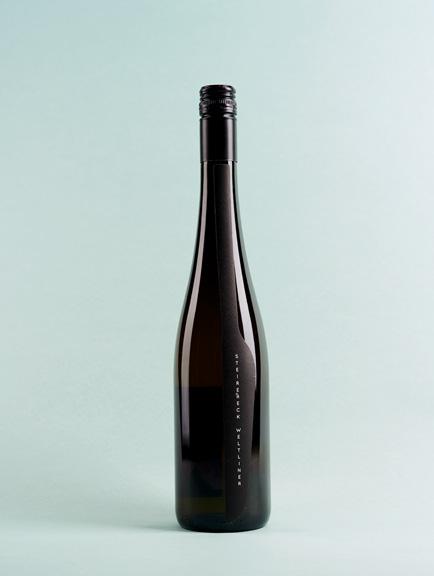
Steirereck has a new addition to its wine cellar. It is the second edition of the house wine, Steirereck Wein. The new wine comes from Burgenland, from Weingut Kroiss, Kroiss vinyard. It is more than a simple Grüner Veltliner, it is a world Veltliner, a world “liner”. Hence the name: Steirereck Weltliner.
It is not just the taste. Which is characterised by a light, fruity note. “A joy to drink!” Birgit Reitbauer knows. “That wine goes with anything.” It is an excellent accompaniment in a convivial setting, as an aperitif or digestif, or for a main course. As shown by the small emblem on the bottle. A knife. Its predecessor had a fork. Perhaps a spoon for the successor? We shall see. For now, enjoy the Steirereck Weltliner to the fullest.
Steirereck Weltliner is availabe in the Steirereck-Shop. Price: € 17,–
10 S MAGAZIN REAL FINDS


 HOME OF FINE WATCHMAKING SINCE 1833
HOME OF FINE WATCHMAKING SINCE 1833
Jaeger-LeCoultre Boutique , Graben 28, 1010 Wien, +43 1 533 80 65
Master Ultra Thin Perpetual. Manufacture movement 868 / 1.
-
- www.zeit.at
LINZ Klosterstraße 2
WELS Schmidtgasse 16
MAIWIPFERL-FLAVOURIT
A FORESTY SCENT WAFTS THROUGH STEIRERECK. THE NEW FLAVOURIT BEER TASTES OF MAIWIPFERLN, “ MAY SHOOTS ”. IT WAS BREWED IN WALDVIERTEL. IN THE SCHREMS BREWERY. IN BEST POSSIBLE CRAFTSMANSHIP.

It doesn’t always have to be cough syrup. Maiwipferln, the young green May shoots on fir trees, make for very nice beer, as evinced by the new Steirereck brew. Master brewer Karl Th. Troian of the long-established Schrems brewery in Waldviertel has brewed this beer by hand exclusively for the restaurant. The secret ingredient is Steirereck’s homemade Maiwipferl syrup. Add to this brewing barley
from Waldviertel, Austrian hops, fresh Maiwipferln, Maiwipferl extract and loomi, and there you have it –Flavourit Beer Vol. 4.
Steiereck has 500 bottles in stock. With its foresty-green flavour, the beer makes a wonderful aperitif. Find out for yourself whether it helps with the common cold.
Flavourit Beer Vol. 4 is available from the Steiereck Shop. Price: € 18,50
12 S MAGAZIN REAL FINDS
Am liebsten schlafe ich direkt am See.

Seehäuser im Eigentum in Neusiedl am See. Direkt am Wasser mit eigenem Steg und eigenem Bootsanlegeplatz.
Jetzt provisionsfrei im Verkauf.
Neusiedl am See Projektentwicklung GmbH
Dipl.Arch ETH Martina von Tippelskirch, MSc
+43 664 458 70 15 | verkauf@amhafen.at
www.amhafen.at
JAPANESE BARBECUE
JAPANESE-STYLE BARBECUE IS VERY HOT, AND DELICIOUS. THE ARTFORM IS CALLED YAKITORI, THE GRILL IS CALLED KONRO. THE COMPACT GRILLS ARE AVAILABLE FOR THE HOME.

Nowadays, people barbecue all year round, and all over the world. In many different ways, with different traditions and recipes. In Japan, Yakitori is a popular barbecue style. Skewers of various kinds of meat, fish, or seafood are prepared on a special charcoal grill, the Konro grill. The advantage: Konro allows for very high temperatures, thanks to a kieselgur coating. Kieselgur, diatomaceous earth, is made from the remains of fossilised algae. It not only keeps the warmth, it can also withstand great heat. Which is why the Japanese Binchotan charcoal, which generates temperatures of up to 1.000 °C, can be used without any problem.
Konro grills are made by hand in Japan. “They are like a small, high end kitchen, which makes them ideal for the home,” Heinz Reitbauer explains. “These grills are not only suitable for Yakitori, but also for everyday dishes. For example, you can use them to cook vegetables.” In short, there is no limit to grilling for this Japanese BBQ, provided the dishes are accompanied by delicious sauces and dips.
Further information: foodconnection-shop.de
14 S MAGAZIN REAL FINDS


12 Almgarten-Suiten mit unendlicher Aussicht 20 x 8 m Infinitypool • Panoramasauna • Außen-Whirlpool Yoga- und Aktivraum • Fitness-Studio • zusätzliche Ruheräume Almwellness Hotel Pierer****Superior . Pierer Gastronomie GmbH . GF Alfred und Franz Pierer Teichalm 77 . 8163 Fladnitz . +43 3179 / 71 72 . hotel.pierer@almurlaub.at . www.almurlaub.at
ALMSEHNSUCHT BRANDNEU AUF DER TEICHALM SEIT MAI 2019 Almfrische Hotel-Gutscheine jetztbestellen!online Hotel-Gutscheine jetzt online bestellen*
© Harald Eisenberger
A GIFT OF PLEASURE
GIVING GIFTS IS ALMOST AS NICE AS RECEIVING THEM. ESPECIALLY IF THEY ARE TO DO WITH TIME OR INDEED FOOD. STEIRERECK VOUCHERS COMBINE THE TWO.

Christmas is around the corner, and the next birthday is sure to happen. Question of questions: What to give? This has to be carefully considered. After all, you want to give pleasure. The Steirereck solution: You can never go wrong with a voucher. If the way to a heart is through the stomach, this goes for love as well as for friendship. Birgit Reitbauer recommends an invitation to a meal. “Breakfast
at our Meierei is a favourite gift. Although Dinner Vouchers are also popular.” For a special anniversary, one might opt to be more exclusive. A night at Pogusch, surrounded by nature, is both relaxing and romantic. If you want to leave all your options open, Steirereck also offers non-specific vouchers. All vouchers can be ordered online and will be sent by post.
The vouchers can be found at steirereck.at
16 S MAGAZIN REAL FINDS
kein hin und her. www.die3.eu Euram Bank AG Palais Esterházy Wallnerstraße 4 1010 Wien T: +43 1 512 38 80 0 F: +43 1 512 38 80 888 office@eurambank.com www.eurambank.com eindeutig
SCREW CORKS
THE ULTIMATE CORKSCREW FOR OLDER WINES. AT STEIRERECK, THE DURAND VINTAGE CORK SCREW HAS REMOVED MANY A SENSITIVE CORK FROM A MATURE WINE.

A true wine saver: In developing The Durand Vintage Cork, American wine-lover Mark Taylor did restaurateurs and wine-collectors around the world a huge favour. This is the perfect tool to open older and mature wine bottles, a clever combination of a spiral and a spring cork screw which easily removes fragile and compromised corks whole, so they don’t
get pushed in the bottle, break or crumble into the wine. The Steirereck sommeliers appreciate the special properties of The Durand Vintage Cork very much, and have used it to free many a bottle from shrewish, stubborn, or sensitive corks without hurting the wine.
Further information: ungerweine.de 18 S MAGAZIN REAL FINDS

CELEBRATING 50 YEARS
STEIRERECK
SWEET: MUSHROOM MEETS MAPLE
STEIRERECK IS BLENDING MUSHROOMS AND MAPLE INTO A VERY SPECIAL ELIXIR. THE RESULT IS A SYRUP, A FERMENTED MUSHROOM-AND-MAPLE SYRUP, WHICH ADDS A DISTINCT NOTE TO DESSERTS.

When the Steirereck Team and Heinz Reitbauer put their heads together to cook up a new delicacy, there are no limits and no limitations to their creativity. It is all about taste. Their newest coup: A natural sweetener for desserts. For this, they combine maple with mushrooms. The concoction is fermented and made into a delicious juice. It looks a bit like honey, its taste is reminiscent of caramel with a malty
note. “It is an exotic journey for the palate”, Heinz Reitbauer is enthusiastic. “It tastes wonderful with rice pudding and vanilla ice cream. And it goes well with baked apples and dried fruit.” Especially in the winter months, the syrup offers a real alternative to candied fruit; it is a delicacy for gourmets besides the winter markets.
The fermented mushroom-and-maple syrup is available from the Steirereck Shop. Price: € 14,50 per 100 ml
20 S MAGAZIN REAL FINDS






























salvatorikaffee.at Exklusiv aus der NABER Kaffee Manufaktur
VEGETABLE RUN
“ KRAUTWERK ”, LITERALLY “ HERB WORKS ”, HAS BECOME INDISPENSIBLE, BOTH ON KARMELITERMARKT AND IN THE CITY’S HAUTE CUISINE. THE MARKET GARDEN HAS IT ALL: GOOD TASTE, VISUAL APPEAL, AND ALL-ROUND PERFECTION.

From IT manager to vegetable farmer. Robert Brodnjak began his dream of Krautwerk on a very small scale. Privately. On his own terrace. “I wasn’t happy with the vegetables on offer, or their taste, and I wanted to do a better job.”, Brodnjak says. And that he did. Today, the professionally trained chef and his family cultivate three hectares of land in the village of Großmugl in Weinviertel. Krautwerk offers quality, and great variety. From carrots to cabbage to potatoes, everything grows in its vegetable beds. Including a few specialities, such as parsnip chervil or flower sprouts, grown in cooperation with Arche Noah, Noah’s Ark. Haute cuisine chefs are rapturous about
the choice. Steirereck noticed Krautwerk already in 2013; they were its first gastronomy customer. The variety of peas brought them together. By now, their vegetable relationship extends way beyond the legume. “Krautwerk is unique. And for me, the best vegetable supplier in all of Europe”, enthuses Heinz Reitbauer.
For all who would like to see for themselves: Every Saturday, Krautwerk can be found operating its plastic-free stall at Karmelitermarkt. Complete with advice on cooking and combining vegetables.
Further information: krautwerk.at
22 S MAGAZIN REAL FINDS
Lust auf Schmetterlinge im Bauch?














Der passende Partner flattert nicht einfach so herein! Finden Sie ihn – mit meiner professionellen Unterstützung.

T: +43 1 877 11 11 www.kinauer-bechter.com
PLEASURE FROM AROUND THE WORLD
RUNGIS EXPRESS IS THE TRAVEL AGENCY FOR EXCEPTIONAL TASTE. AS PARTNER FOR OUTSTANDING FOOD EXPERIENCES, OUR COMPANY DELIVERS FRESH FOODS FROM MORE THAN 60 COUNTRIES RIGHT TO YOUR DOORSTEP.

Time for a journey of discovery to select food terrains around the globe. Rungis express offers unique food experiences across the world. From more than 60 countries in four continents. Made possible by a network of 700 suppliers and contractors. They ensure that customers receive their food from the desired place, from the farmer next door or the farmer at the other end of the world. Freshness is our utmost priority.
We ensure the smooth transport without intermediary storage, so that customers receive their goods as quickly as possible. At the same time, we pay attention to climate protection and sustainability. It is an integral part of our philosophy to take responsibility for our environment, humans, and animals, and to be transparent and ecologically sound with regard to provenance, production, and transport.
Further information: rungisexpress.com
24 S MAGAZIN REAL FINDS

IT’S TIME TO FLY
WITH ITS HOT BALLOON, L’ÉPÉE 1839 HAVE CREATED A TRUE WORK OF CLOCKMAKING ART. A CLOCK IN THE SHAPE OF A HOT AIR BALLOON. A SUSPENDED CLOCK WITH A FLOATING PRESENCE. TO BE SEEN AT UHRMACHERMEISTER HÜBNER.

All aboard the Hot Balloon. The new mechanical pendulum clock of the Swiss manufacturer L’Épée 1839 takes the unusual shape of a hot air balloon. The design was developed through the Masters programme in Advanced Studies in Design for Luxury and Craftsmanship, of the Ecole cantonale d’art de Lausanne (ECAL), an official partner of L’Épée 1839, in close collaboration with talented design student, Margo Clavier. Inspired by the eponymous aircraft, it symbolises a sense of adventure, exploration, freedom, and above all, travel.

The artful timepiece consists of 207 components, all handmade at the L’Épée 1839 manufacture and assembled by hand. The outstanding feature is the blue balloon. The kinetic sculpture can be placed on a table or suspended from the ceiling, appearing to fly through the air.
Hot Balloon was created in a limited edition of only 50 pieces. If you want to see this wonderful piece, you may do so in Uhrmachermeister Hübner’s shop.
Further information: zeit.at
26 S MAGAZIN REAL FINDS

THE VIP-TRAVELLER
TRAVEL LIKE A SUPERSTAR: THE VIP TERMINAL AT VIENNA AIRPORT OFFERS PURE LUXURY, AND NOT JUST FOR ROCKSTARS AND HEADS OF STATE. EVERYONE IS MADE TO FEEL WELCOME IN THE TERMINAL ’ S NEWLY DESIGNED ROOMS.

The VIP Terminal at Vienna Airport invites its guests into a very special and utterly relaxed world of travel. Passengers can enjoy the time before their flight in their own VIP room, surrounded by our new Viennese Art Nouveau furnishings. Comfortable chairs and sofas invite you to sit. If you prefer to take the long view, relax in our swank Skyview Lounge with its spacious terrace, where you can enjoy culinary delights and fine drinks.
While our guests enjoy the advantages of the VIP Terminal, our experienced staff deals with the formalities, from check-in to passport and border control. When all is done, a luxury limousine will take you directly to the plane. You do not have to be a superstar to land at the VIP Terminal. Everyone can book our VIP Service, whether your flight is on a private jet or a scheduled flight, economy or business class. With the excellent service of the VIP Terminal Team, flying becomes a joy. And we guarantee a stressfree arrival at your destination.
Further information: viennaairport.com/VIP
28 S MAGAZIN REAL FINDS
It was Albert Einstein, who knew, “There are only two ways to live your life: as though nothing is a miracle, or as though everything is a miracle.”
So why not make the second option your creed? To give yourself over to enjoyment, sensuality, joy? To take what the universe has to offer?
To think of that may delight – when there is a tempting Reinanke on the table. Or a beautifully baked pork schnitzel. Or a colourful arrangement of fresh vegetables. How about aubergines? Hardly anyone knows how many kinds there are. You almost want to call out, “Look, a miracle!”
Who & why
S. 30 SPAWN AND BEAUTIFUL S. 56 PIG ECONOMY S. 62 LIFELONG LOVE S. 38 YOU REAP ONLY LATER S. 46 THE FRUIT FROM ARABIAN NIGHTS
1 29 S MAGAZIN HARVEST & DELIGHT
SPAWN AND BEAUTIFUL

ONCE A YEAR, JUST BEFORE CHRISTMAS, THE REINANKEN, A SUBSPECIES OF COREGONUS FISH OR WHITEFISH, SWIM TO THE SHORES OF MILLSTÄTTER LAKE TO MULTIPLY. ALEXANDER MOSER, A FISHERMAN FROM DELLACH, LENDS A HELPING HAND.
TEXT:
SEBASTIAN HOFER PHOTOS: PHILIPP HORAK
S MAGAZIN 30 FISHERMAN VOCATION

31
Of course the swans get in the way, it is their nature. They show absolutely no respect for Alexander Moser, 31, nor his mother, Anita. They bite. They have no inhibitions, or compunctions, they shamelessly, sneakily bite; they even find their way into the boat. They are after the fishy innards, hearts and kidneys of the coregonus fish, wild catch, best quality. From their point of view, very understandable. There again: Do they have to? And why now?
Now. That is a Saturday in October, it is 7 am on Millstätter Lake. Alexander and Anita Moser are up and about before the crack of dawn. The lake clear as a mirror, the Nockberg mountain range shimmering in the half-light. The first sunrays venture over Mirnock Where according to ancient lore, a giant once lived, who fell in love with a fisherman’s daughter from the lake. He kidnapped the girl, as you do, but then stumbled and fell over his penchant for schnaps, and finally, angrily, destroyed half the mountain.
Which is why the sunrise over Mirnock today is breathtaking. At times like this, Alexander Moser loves his profession, swans and cold aside. Alexander is a professional fisherman in Dellach; in this capacity, he is the co-star of a two-person-drama, played out almost daily from March to October. Anita Moser is the other star. First Act: Take out the boat before sunrise, lift the gillnet, take out the catch of the day. Second Act: clean and gut the fish, ignore the swans. Third Act: get on the phone.


01-02
swans
An autumn morning at Millstätter See (Millstatt Lake).The
This third part is stressful for Alexander Moser. “You only know over the course of the morning how much fish you have to sell. Naturally, you have a hunch, but it can be much more or much less. In any case, you have to reach your customers quick as you can. Not easy when you are dealing with gourmet chefs. In my experience, it is best around 11 am. From 12 noon you are in your car, delivering.” know exactly that a feast awaits them.
32 S MAGAZIN FISHERMAN VOCATION
The miracle reliably happens once a year, usually in mid-December.

33
03 Alexander Moser, professional fisherman, listens to nature.

S MAGAZIN 34 FISHERMAN VOCATION
Alexander Moser gets in his car in Dellach, on the north shore of Millstätter Lake, at the foot of the Nockberg range. The village has fewer than 200 inhabitants, but a very long fishing tradition, going back over a thousand years. Fishing is first mentioned as a feudal privilege in 891, in a document of Carolingian King, Arnulf of Carinthia. In 1457, Emperor Frederick III grants Millstatt Abbey fishing rights in return for the provision of no fewer than 200 salmon trouts per annum to his court in Vienna. The descendants of the last court fishermen at Millstatt still hold extensive fishing rights on the south shores of the lake. Alexander Moser’s grandfather purchased the fishing lease in Dellach after World War II and passed it on to his children. “As a boy, I used to go fishing with my parents, but I never wanted to be a professional fisherman,” recalls Moser. The question simply did not arise; continuous overfishing led to a dramatic decline in fish stocks between 2009 and 2014; the lake’s ecosystem was in jeopardy. But then the opposite occured, “All at once, there were so many fish, my mother could not keep up.” Alexander, who by that time was studying ecology and management of biological resources in Vienna, returned home to lend a hand, stayed on, and found new customers.
By now, “Mosers Wildfang”, Moser’s fishing company, has acquired an excellent reputation among Austria’s gourmet chefs and gastronomy experts. At Steirereck, Moser’s Reinanken are prepared with watermelons, fennel, and green almonds. Says Heinz Reitbauer, “We gently cook the filets in an aromatic oil; we prepare them as confit. This suits this fish, it would be easily overdone. You could of course also fry it, but that too has to be done with great care.”
Alexander Moser prefers to eat his fish raw, prepared as Peruvian ceviche for instance. “Not a problem, because the water is clean and the fish is fresh.” Next year, Alexander Moser plans to sell his wild catch to more private customers in Vienna. For that to happen, he needs a miracle. A yearly miracle, which happens reliably once a year, usually in midDecember, about two weeks before Christmas. The fish come to the shore of Millstätter Lake. They don’t normally. The rest of the year, they swim in the middle of the lake, far from its shores, in the deep, in its socalled thermocline, where the temperature changes drastically, and where there is the most plankton.
“The Reinanke is the quickest fish in the lake, its needs space and deep water,” Moser explains. The Reinanke, Latin name coregonus, is a whitefish in the salmon family, grows 30 to 50 centimetres in length; it is recognised by its pointed head and forked tail fin. The species originally inhabited the Arctic Sea; after the last Ice Age, it migrated to the Austrian lakes. Other German names are Felchen or Renke. In Austria, there are two main variants of the species, the smaller Blaufelchen and the larger Maräne, and there are local subspecies in Austria’s lakes. “Each lake has its own species”, says Alexander Moser. Would he know where a fish was from, just by looking? “No, but I would know the ones from Millstatt.”
In ecological terms, coregonus has only recently arrived in the Drau Valley. According to the Federal Austrian Forestry Commission (Österreichische Bundesforste), which oversees the majority of fishing
04-06 “Every lake has its own species of Reinanken”, says Alexander Moser.
The sperm of male fish, the so-called milt, is added to fertilise the spawn.


35
“The entire family has close ties to fishing.”

on Millstätter Lake, the species was first spotted there in 1906; other sources maintain an even later date for its arrival. Ever since, the number of coregonus in the lake has varied greatly. This is another reason for Alexander Moser to be alert in December, when nature takes its course. For when the fish approach the shores, they are following a natural law, i.e. their reproductive instincts. Coregonus fertilise their eggs in open water, and they prefer to do this in shallow waters - for reasons of accuracy. And the Millstatt fishermen are glad to lend a helping hand.
Alexander Moser reaches into the net and does something he only does in December: He takes each fish and feels for an arching belly, a sign of roe in a female. He then strokes the fish from head to tail, massaging the roe from the fish. “That is not difficult. It is quite literally a matter of feeling, to make sure there is no blood or dirt mixed in.”
The semen or milt of one male fish is added to ten to fifteen batches of roe; the spawn is then cleaned, rinsed, and stored in fresh water. The fish eggs are then taken to the Brugger Fish Hatchery in Dellach, to Alexander’s cousin Georg. The entire family has close ties to fishing: Aunt Ingrid Brugger is certified female fish farmer in Austria, Cousin Carina has a fish diner in Dellach, Cousin Georg runs the hatchery and is a professional fisherman, and his mother distributes their catch to the local markets.

In the hatchery, the spawn is kept in water under controlled conditions, until conditions in Millstätter Lake, i.e. temperature and plankton, are ideal for the larvae. This occurs usually in March. From then on, the larvae are left to their own devices. Only a small portion of the millions of larvae survive the first, dangerous days. Those who make it, have a rich life ahead. With an average depth of 90 metres and stable temperatures, Millstätter Lake is a paradise for the coregonus fish. Thanks to its 200 contributing rivers and streams, it is also rich in oxygen. Ideal conditions; which means the tender white meat can develop into the highest delicacy. There is only one downside to this life: The fish don’t get to see the sun rise. But then you cannot have it all.
07–08
The fish-to-be spend the winter in the hatchery of Alexander Moser’s cousin, Georg.
36 S MAGAZIN FISHERMAN VOCATION

Nature takes its course –with a bit of help.
09 Stripping roe: “A matter of sensitivity”, says Moser.
37
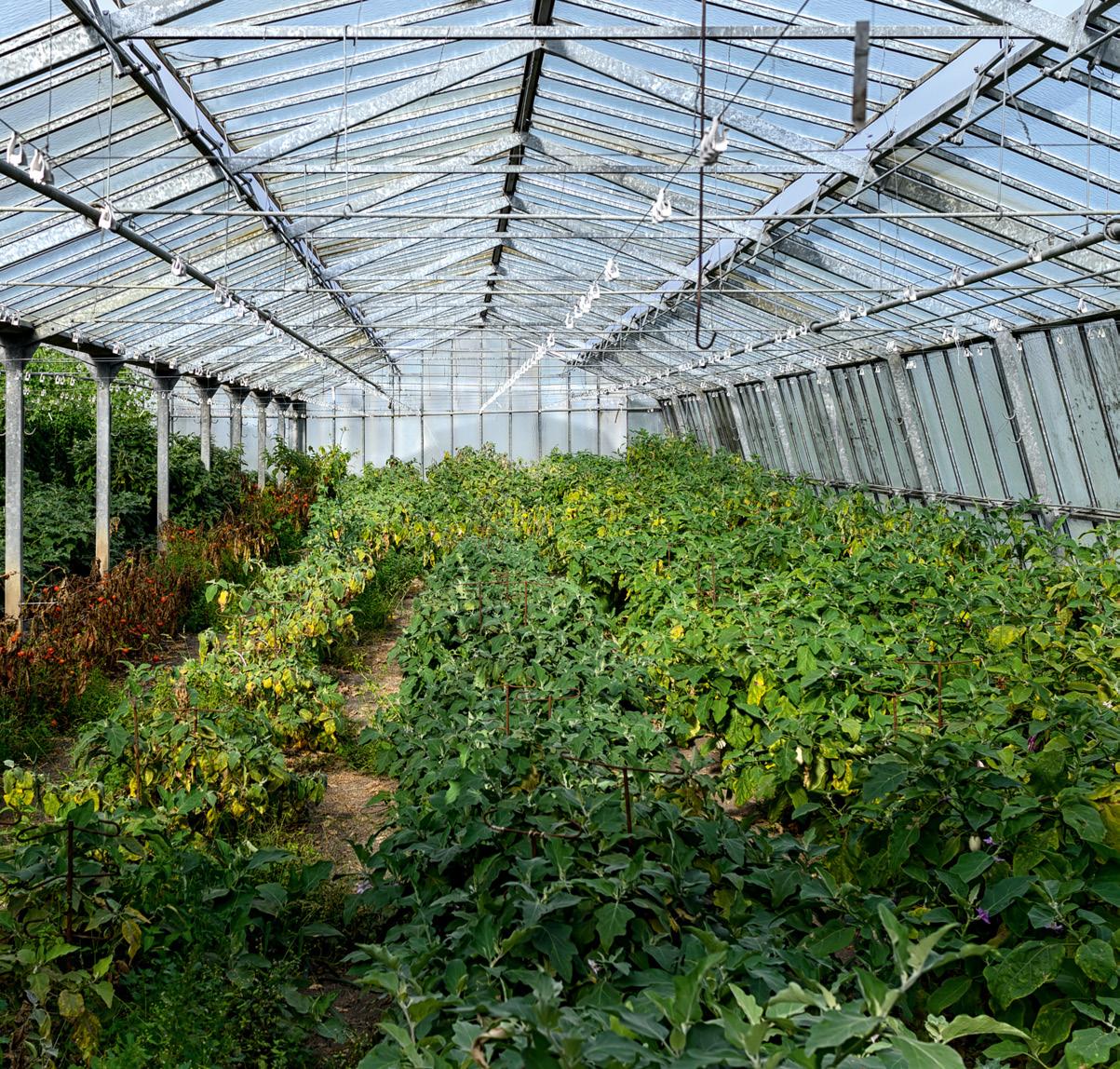
YOU REAP ONLY LATER
38 S MAGAZIN VEGETABLE WORLD

In Vienna’s Donaustadt district, Evi and Mario Bach have created a small vegetable and herb paradise. Slowly but surely, their nursery has grown from an insiders’ tip into the go-to address for outstanding quality.
TEXT: USCHI KORDA, PHOTOS: MIRCO TALIERCIO
39
It is something of an expedition. The Viennese who crosses the Danube heading northeast, finds herself in unknown territory. Anyone who doesn’t live here, normally only ventures as far as the Old Danube or to Lobau, no further. Further afield, growing business parks expand to the flat horizon, crisscrossed by multi-lane carriageways, their monotony every now and then relieved by a roundabout. Where the outskirts of the city loosely spill into the Lower Austrian Weinviertel, where small settlements of single family homes dot the fields, with names like Peony, Orchid or Milfoil Lane.
If you have no sense of direction, this alone would tell you that you are on the right path, especially when looking for Vienna’s most extraordinary nursery. Eveline and Mario Bach reside in Transdanubia, their magic garden lies in Hänischgasse, named after – and this is definitely advanced knowledge of Vienna – Aloys Hänisch (1866–1937), a cofounder of the Vienna Secession; Hänisch, a painter, specialised in pictures of gardens and flowers.

En route, more and more greenhouses appear on the scene; those belonging to the Bachs seem somewhat nostalgic. They nestle, gracefully, as if ashamed, dwarfed by the outsized high-tech installations around them which provide eternal season for tomatoes. High-tech is certainly not the main factor in the Bachs’ oasis of vegetables and herbs. Although the Bachs do not reject technology; they are not stuck in a bygone era. However, in their nursery, nature remains the determining factor. If nothing grows, there is nothing to sell or buy, says Mario Bach matterof-factly, scowling in the manner of a Viennese market vendor faced with a customer demanding, say, spaghetti beans on the spot, when they are out of season. The Bachs plant and harvest in strict accordance with the seasons, although they have managed to prolong them for certain varieties – by natural means. After years of experimenting, researching, and learning by doing, there are fresh vegetables and herbs from the end of March until the end of October, and then it ends. Nature rests in winter, and the soil in the Bachs’ nursery rests as well. The two gardeners take it somewhat easier then; emphasis on the -er. For now, the seed for the next year has to be sown and planted; this does not happen by itself. Eveline, called Evi by everyone, and Mario Bach and their two employees work their 800 square metres of land and the greenhouses with roughly the same area. It is not much; certainly not enough land to supply the trade: but this does not interest the Bachs. The small size of their nursery allows them to look after every aubergine, cucumber, bean, or courgette, every leaf of lettuce or mint, from its germination to the harvest. This kind of quality in addition to a paradisical variety of produce, makes the Bach Nursery the place to go to for gourmet chefs in Austria’s East. It is an insiders’ tip – it is many things, but not secret anymore.
“We never made a big fuss or drama”, says Mario Bach, and while there is an undertone of the Viennese grouch in his voice, you can definitely hear the proverbial Viennese “golden heart”. True to form, he is a typical Viennese, he says, he was born here, raised by a Greek mother and a Viennese father. A perfect mix, as has been traditional in this city for centuries. The nurseries near the Danube have an equally long and ongoing tradition, they supply the city with fresh fruit and veg, from the boroughs of Simmering, Jedlesee, and Hirschstetten. Evi Bach’s ancestors arrived in the capital from Waldviertel in Lower Austria; they founded their nursery in Hirschstetten in 1899. It was a craft you could live on, says Evi. While she gently plucks a whitered leaf off the winged beans,
01 Even in October, you can enjoy different kinds of aubergine, as well as melothria, a small cocktail gherkin.
40 S MAGAZIN VEGETABLE WORLD

02 Gardening is in Evi Bach’s blood, husband Mario had to grow used to it. He is the man for all things technical in this abundant plant paradise.
she spots a small ripe aubergine in another bed. “Heinz Reitbauer will like this”, she says, as her mobile rings again: Another chef wants to place his order.
We meander through the greenhouses, where autumn has well and truly set in. On the floor between the rows of different plants lie the irrigation pipes; the green of the last months has faded. Irrigation is meted out in drops and by hand, as each plant needs a different amount of water. No automated software could handle that.
In her empire, Evi Bach probably knows each plant personally.
41

This is something you learn for life here: Not everything is possible, no matter how much you may want it.
03-04
Right: When staff member Vassily talks to Mario Bach, everyone else is quiet. The Bulgarian and his boss prefer to speak Greek to each other. Above: Multi-coloured chard.
VEGETABLE WORLD S MAGAZIN 42

43
“I love going through these rows in summer, in the evening, when everything is lush and green and it is still light,” says Evi, “it gives me energy.” She could not deny her love of gardening if she tried. You sense that she knows each plant in her empire, she knows in which corner she might still find ripe specimens of an exotic cucumber variety the size of a fingertip, and which of the dried beans might yield the best seed.
She quite likely never had a choice to become anything but a gardener. At 15, she started her apprenticeship and began to slowly grow into her parents’ business. In 1946, her father was one of the founders of LGV, an agricultural cooperative of over 1.000 gardeners in Vienna. For economic reasons, he opted for large-scale cultivation of only a few kinds of vegetables. “Not my cup of tea”, says Evi, adding that her own history has much to do with the development and growth of the city. In the 1970s, Vienna grew in the North and in the East. As young families started to arrive, demand for fresh vegetables rose, as did the desire to buy directly from the producers. “Now that was to my liking”, says Evi, and as more and more local restaurateurs and innkeepers came, she expanded her range and worked on improving the quality. Away from mass production, towards something singular, special. Her parents had misgivings about their daughter’s move towards the small-scale, but Evi stuck to her guns.
Austrian herb specialist Miriam Wiegele’s expertise fuelled Evi’s own enthusiasm for herbs. Meanwhile, husband Mario, who graduated from an HTL, an Austrian Technical College, came up with technical improvements, such as a tinfoil tunnel for courgettes, which prolongs their harvest time until autumn and which keeps the blossoms tender and clean – only these blossoms are used in the Steirereck Kitchen.
Over the course of the years, their love of nature and curiosity made Evi and Mario Bach collect plants and seeds from all over the world. At home, they planted everything from Mexican yerba santa (Mexican pepperleaf, Vera Cruz pepper) to Thai water cabbage, from rosette bok choy to Egyptian spinach, to see how these plants would fare in Austria. Not everything thrived, and some ideas were simply uneconomical, such as growing green beans outdoors, or muskmelons in a greenhouse, or growing physalis, which fell victim to spider mites, in spite of non-chemical pest control. “This is what you learn for life in a nursery”, says Mario, “sometimes things aren’t possible.”
Among the first to notice the wondrous diversity produced by the Bach Nursery was legendary gourmet chef Meinrad Neunkirchner, known as master of essences, who all his life brought out the best in herbs and vegetables. This would have been about twenty years ago, the Bachs don’t recall the exact date. Today, everyone looking for something special or unusual in gourmet cuisine knows to call the Bachs first. If they cannot help, no one can.
We are now between the greenhouses, we are looking over the harvested beds and fields to the far horizon. “It was the right decision”, says Evi, “to specialise and remain small.” This gave them more freedom, the limits were only imposed by nature herself. And by the city, which has started growing again in the last few years and which has needed more of the Bachs’ land in Hirschstetten. So two years ago, the nursery moved further to the outskirts, to Breitenlee, where the family has owned land since the 1960s.


44 S MAGAZIN VEGETABLE WORLD
05-06 Germinating offshoots: soon to be snow peas.

07 In the glasshouses, autumn has already set in. Until recently, padwal, citrullus, and Sikkim
were harvested here; now, only the irrigation pipes are visible.
“We weren’t sure whether we should uproot ourselves at our age”, Mario says, who at 59 certainly does not look ready to sit still on a bench and dream into the sunset. Quite the reverse, he combined all his technical knowledge and his years of experience to build a new, environmentally sound nursery complex complete with solar energy, pellets, and mechanical irrigation systems. Naturally, everything at Bach’s is organic, although not officially certified, because there is no time for the administrative side.
What time there is, is spent on the vegetables, the herbs, and the edible blossoms, which have become a passion of Evi’s. It has grown cold now, mist is wafting from the Danube. “It’s time”, say Evi and Mario Bach, “there is still much to do.” After all, they have to begin preparations for 2020. “This is another thing you can learn for life from gardening”, Mario says by way of farewell, “you reap only later.” And that includes success.
cucumbers
45

46 S MAGAZIN FRUIT DELIGHTS
TEXT: UTE WOLTRON
The aubergine is one of the next delicacies whose many varieties remain to be discovered. Incidentally, it does not have to be dripping with fat. It can truly seduce your palate, if you know how to prepare it.
OPHELIA
The aubergine has to achieve a brilliant lustre, only then will it be cut from the plant to be used as quickly as possible. The name aubergine comes from the Arabic. The plant has doubly enriched our vocabulary; its name also denotes an extravagant shade of purple.
The Fruit from Arabian Nights
PHOTOS: KLAUS FRITSCH
47
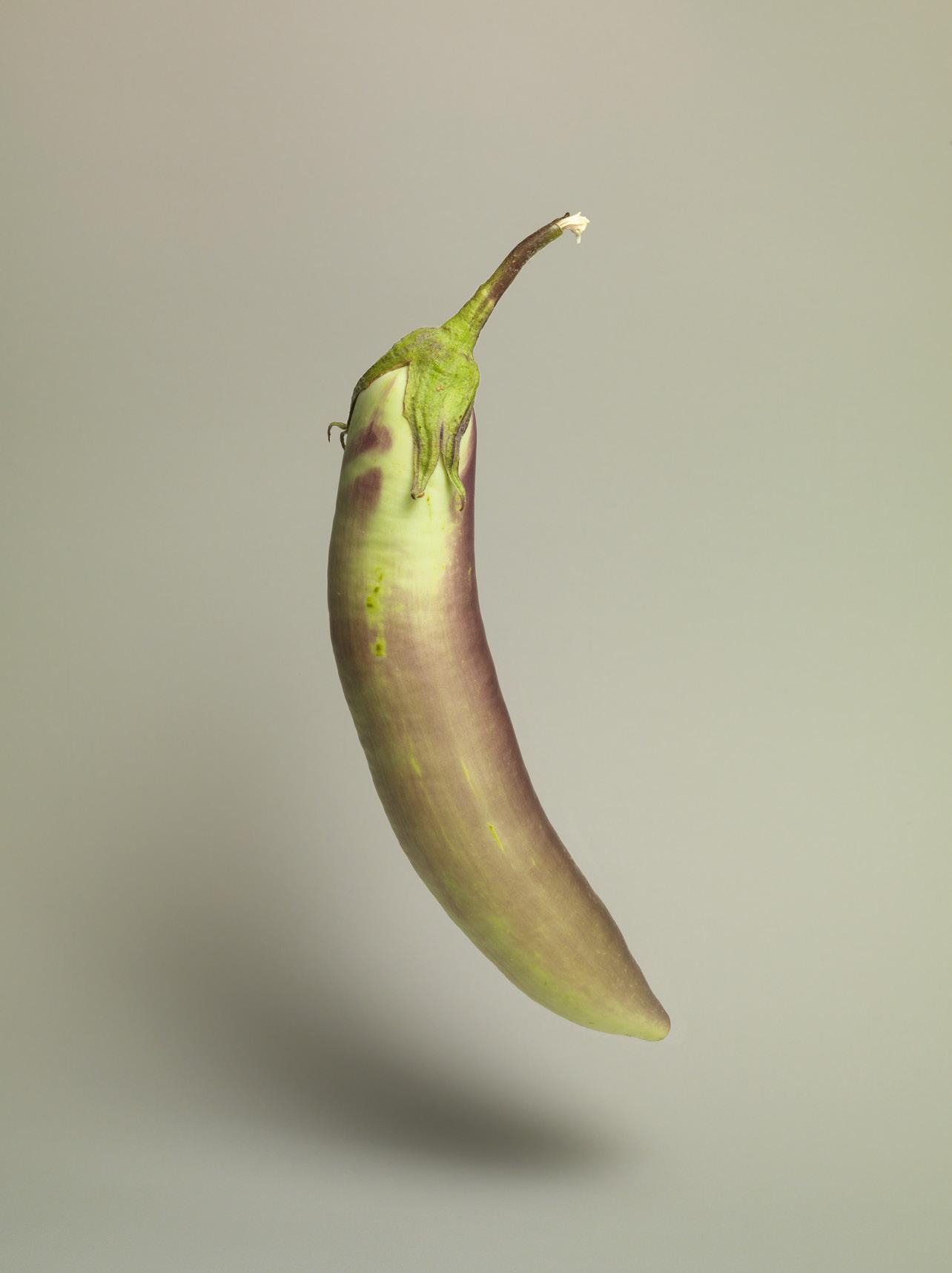
48 S MAGAZIN FRUIT DELIGHTS
Friends of the vegetable cuisine are able to enjoy an increase in vegetable choice, and able to delve into the abundance of old and almost forgotten varieties. Since the renaissance of the tomato, with its many different kinds which now inhabit the vegetable section of our supermarkets, master chefs and hobby cooks alike are free to experiment with the interesting tastes and textures of different varieties of carrots and potatoes. In the same way, the fruit supply has become more colourful and multifaceted of late. But there is one fruit, still awaiting its time to be tried, tested, and praised. The local culinary community, inexperienced in this regard, has this to look forward to: the aubergine is a hot tip item for any vegetable lover.
Most people will have heard of the aubergine, though probably not appreciate its true value. Hardly anyone knows that this fruit, which we mostly associate with its dark blue club shape, and which is also called Melanzani, from the Italian, comes in countless shapes and sizes. They have little in common with the familiar purple giant, and their tastes and textures vary greatly. You might say, an aubergine does not equal an aubergine. Rather, it is a versatile delicacy, and its many varieties are as diverse as the stories in Arabian Nights.
ORIENT EXPRESS
This Asian kind is longer and slenderer than most other aubergines. It is comparatively small and has a thinner skin than its more voluptuous colleagues. In Asian cuisine, the fruit is eaten with the skin, as it is tender and sometimes even aubergine in colour.
Speaking of which, the aubergine’s history is just as fantastic. This solanaceous plant loves the warmth; it did not originate in Italy, as one might think, just as Sheherazade’s fairy tale collection is not originally Arabian. Both have their roots in India. In fact, the story of the Magic Horse even mentions the fruit. It features a centenarian, who has been promised the youngest and naturally the most beautiful princess as a wife. He, on the other hand, is not only old, he is also incredibly ugly. “He had a nose like Bedindjan,” reads the text, and that, as you may have guessed, is an elongated kind of aubergine.
49

50 S MAGAZIN FRUIT DELIGHTS
Over a thousand years ago, the Arabs imported the ancient stories from the subcontinent into their own culture, as well as the the plant, which had been cultivated in India and in China for at least 4000 years. They wrote down the tales, which until then had only been passed on orally, and they adopted the fruit while they were at it, as one of the quintessential ingredients of their cuisine. With the Arabs, the adaptable food arrived in Spain and from there, conquered the entire Mediterranean. The Greek and Italian cuisines, in particular, have been using the aubergine since the early 16th century. Here in Austria, we have only just begun to understand that the true quality of the fruit, which is actually a berry, lies in the exploration and investigation of its many different kinds; and we owe this insight to enterprising gardeners.
are all equally difficult to cultivate, they need a lot of care. They all grow to sizeable plants with large leaves, and beautiful purple blossoms. In warmer climes, the plants are perennial, in our colder climate, they have to be grown anew every year. The exact genealogy of the many subspecies and their variants, often with several names, is a science apart. By now, Eveline Bach has experience, she can tell what a fruit will be like by its shape and colour.
Eveline Bach is one who could write volumes about the various kinds of aubergine and about what to do with them, in the same way that many others have written about the tomato. She is one of the few master gardeners who are conducting research on aubergines, who keep testing ever new varieties. For the last twenty years, she has bred many kinds. She acquires seeds from everywhere, from Italy, Thailand, India. Her regular customers will sometimes bring seeds from their journeys. Almost 50 different kinds of aubergine grow in the glasshouses of the Bach Nurseries in Vienna, and none resembles the other. If you venture into the aubergine area and see the fruit, gleaming as if polished in purple, white, red, in striped and other patterns; if you look at their long, round, or club shapes, you might feel a little like Aladdin in that cave of jewels. The small round white specimens which look like eggs depending on a stalk are especially beautiful, and they are responsible for their other international name of eggplant. As different as they may be, they
EASTER EGG
The perfect name for a perfect fruit; you don’t have to think too hard. The small, egg-shaped kinds of aubergine, of which there are many like this one, are an Asian speciality. They are very popular for pickles and chutneys, and very good for canning.
51
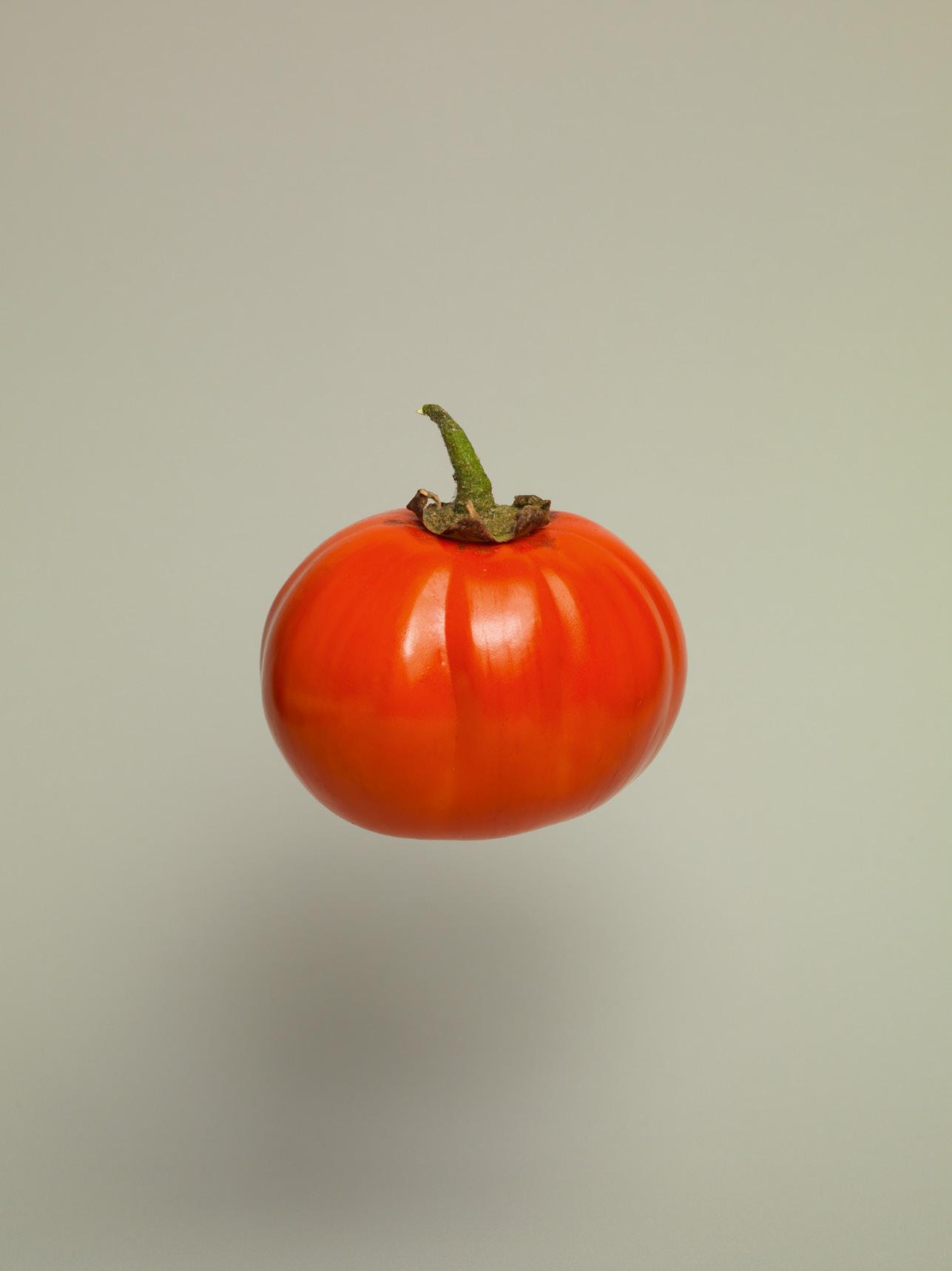
52 S MAGAZIN FRUIT DELIGHTS
The flesh of the white varieties, she says, is usually firm, whereas that of the purple ones is softer and ideal for purées. Smaller and elongated slender aubergines are good for canning, and particularly attractive fruit are sometimes used by florists. The taste spectrum extends from sweet and mild to peppery, slightly hot, fruity, and bitter. The more modern kinds are hardly ever bitter, the older ones can be very bitter, at least for our underused palates. In Thailand or India, these small bitter varieties are sought after, they are considered delicacies. The Steirereck chefs make use of these different characteristics. One of their favourites is called Rossa di Rotonda, and you have to look closely to know the bright red and relatively small fruit from a tomato. Unlike other aubergines, this one does not change or lose its colour when cooked or marinated. In addition, its flesh is particularly fine and firm, with a fruity taste.
Another favourite is called Rotonda Bianca, it is also round, ribbed, and coloured white and purple. Its soft flesh is perfect for canning, and the Steirereck chefs like to give it a more sophisticated kick. The fruit is sliced into round discs, which are then cooked in stock. They readily absorb the aromas; they are then dried, sometimes desiccated. At the end, they give a rather exciting and intense taste. Even the pits of a ripe aubergine are a delicacy; they are served gently steamed. To Heinz Reitbauer, the aubergine is a “small miracle fruit”, which can be combined with almost anything. It goes with meat, it goes with fish, it can be served as a starter; if treated right, it can even be a main course. According to him, the fantastic and astonishing differences of the individual varieties are best sampled at a parallel tasting. The differences in taste are even greater than with tomatoes. Great variation.
ROSSA DI ROTONDA
Arabian and Asian cuisines have been making use of this for a long time; the difference in varieties is reflected in their different uses. Certain classic dishes like Baba Ganoush, an Arabian purée made from aubergines and sesame, have by now made their way into our domestic cooking, and are becoming more and more popular. Our recent discovery of the aubergine owes much to the arrival of persons who are familiar with the fruit, and who ask for it in the shops. The supermarkets have not yet picked up on this in their product range, but there are specialists like the Bach Nurseries, who are happy to oblige as producers. The oldest extant recipe focusing on aubergines, by the way, is found in the Chinese Qimin Yaoshu, an agricultural handbook of food and drink during the Wei Dynasty. It was written in the sixth century AD and contains, besides cultural instructions, a large number of recipes. According to this ancient recipe, the aubergine is fried with other vegetables, in a kind of ratatouille.
Even the trained eye of a professional chef may at first glance confuse the Queen of the Aubergines with a globe tomato, due to its shape and colour. The beautiful tomato red does not only look appealing on the plant, it stays just as bright after cooking or frying.
53

54 S MAGAZIN FRUIT DELIGHTS
We who are only just beginners, may consider the aubergine as merely absorbing huge quantities of frying oil. But frying is hardly the best way to treat an aubergine; there again, we are not eggplant professionals. One of the most ingenious ways to cook an aubergine does not require any fat at all; but it is tricky. Cooked whole in an oven, slowly and over a long time, the flesh becomes a soft melting substance, which can be used in as a basis for many sophisticated dishes. One thing the aubergine cook must never forget; you must prick the fruit prior to heating. That is a mistake you will not repeat. If you forget to do it, the fruit, simmering in its own juice, will explode, as the steam cannot evaporate.
Growing eggplants in your own garden does not always meet with success, these plants require a lot of care. And unfortunately, insects, such as potato beetles, love them. If you have a glasshouse, or in long, warm summers, with cooler nights, you stand a better chance. As the fruits mature slowly, you will need to sow the seeds under glass early, in January or February. You will have to repot several times, as needed; the Asian plant, which is sensitive to cold, must not be moved outdoors before the end of May. It requires a sunny spot, sheltered from the wind; it needs even more warmth than a tomato. The first fruits can be harvested at the end of June, but we still lack experience. Eveline Bach, who by now has a keen eye for aubergine ripeness, recognises the perfect time to pluck by the skin’s sheen, and by gently squeezing the fruit. If the flesh yields, the aubergine is ripe for the plucking. Unripe fruit, and this is useful to know, will discolour more quickly than ripe ones; if the skin of an aubergine still attached to the plant turns yellow, it is too late to harvest it. However, you can still use the seeds.
STROKE OF LUCK
When different kinds of aubergine are allowed to flower next to each other, they will naturally marry and create a new generation in their seeds. If you plant them, you will be rewarded with a hybrid displaying different traits of their parents. That can result in something very beautiful and tasteful, like here.
55

Pig economy
TEXT: KATHARINA SEISER, PHOTOS: MIRCO TALIERCIO
It is part of Austria’s culinary heritage, and a favourite across all classes: pork. But pigs are kept under worse conditions than any other animal. A plea for indulging with a conscience in 26 chapters.
56 S MAGAZIN PIG PASSION
AAustria
No one wants to know, but it is unfortunately true: almost all pigs consumed in Austria or elsewhere in the EU, have never in their lives had grass underfoot (or underhoof) or sun on their backs, they have never had the chance to galop around
and root in the ground with their snout. This is not part of conventional pig farming. The only exception: free range farming.
BBenefit
Your pork roast will benefit you for at least three days: On the first evening, you have to prepare the meat, rubbing garlic and cumin into it and leaving it to marinate, which will give you sweeter dreams than most cakes. On the second day, you slowly roast it, and promising smells waft from your kitchen into the stairwell. Hopefully it is your kitchen, and not that of your neighbour. And on the third day, you can enjoy the cold roast and bread with drippings.
CChina
China is the no. 1 pork nation on the planet. Of the 110 million tons of pork “produced” every year, 50 million come from China. Unfortunately, the meat used in restaurants for the many famous Chinese pork dishes almost never comes from organic farming. But Sechuan pork belly with fermented bean paste, for instance, is not difficult to make. You can definitely try this at home.
DDrippings
Or ham on the bone? Drippings (as opposed to pure lard) contain a layer of jellied gravy, whose flavour of garlic and cumin mixes beautifully with that of lard on rye, baked in a wood chip oven; as classic a taste as tomatoes with basil.
Ham on the bone, on the other hand, cut by hand, juicy and mild, is best served on a buttered breadroll, as part of an elegant afternoon tea. But only if you have fresh horseradish.
EExpensive
The German word “Eichelschwein” translates as “acorn pig”, the Spanish pata negra is also the old designation of the cured ham. Iberian pigs are usually black; they range freely in sparse oak forests (Spanish dehesas) and feed on acorns. Their ham has a sensational scent and taste. Note that only “Jamón Ibérico de Bellota” is the real deal –and it is really expensive.
57
FAfter 10.000 years of pig farming, people still aren’t aware that a pig has more to offer than sausage meat, bacon, and filet. Properly cooked, pork filet, in proper Austrian Schweinslungenbraten, can be a delicacy, but it is not the best part of the animal. The whole is best.
GGuanciale
Guanciale Bacon, Geselchtes (Austrian smoked meat), and Grammelknödel (dumplings with pork drippings): that is the genuine Trinity of Decadence. Anything smoked is listed as endangering your health. The same goes for the dumplings, which might enlarge your own circumference. And for Guanciale, because the wickedly tasty bacon is the essential ingredient for Spaghetti Carbonara, and you can never have enough of those.
HHome Slaughtering is allowed for pigs, but only for one’s own needs. “Sautanz” (literally “Sow’s dance”) is an old Austrian word for the ceremonial butchering of an individual pig on a farm, followed by a feast. Traditionally done in winter, sausages are made, crackling and dripping produced, bacon cured and aspic cooked, in short: the entire animal is used.

IIslam
In Islam and Judaism, pork is taboo, and its consumption is forbidden. This can cause conflicts between belief systems, e.g. when a kindergarten decides to not have pork on the menu to be able to cater for Muslim children more easily and without added expenses. A less contentious and better solution might be to offer a daily vegetarian dish. That is allowed in all religions.
JJoy
The difference between East and West in Austria is apparent in words as common and much-loved as Jause, the Austrian tea meal. While in the capital and the East, this means coffee and cake, from Upper Austria on, no Jause is complete without the joy of pork, in the form of bacon. In the West, Jause is a savoury affair of bread and bacon, usually with a pickle. In some cases, this can extend to Erdäpfelkas, cold cuts and schnapps.
Filet
58 S MAGAZIN PIG PASSION
KKnowledge
Farrowing Crates have no religious connotations, and they aren’t noble either, but a euphemism of the worst kind. This refers to the narrow iron cage in which the mother sow is strapped, so that she does not crush her piglets (thus diminishing the potential profits), that is the official wording. For weeks, the sow is unable to even turn.
Best practice pig farming, i.e. free range farming, offers completely different experiences. A sow, who has enough space and litter, will look after her young ones, and will not deliberately crush them. That knowledge is important.
MMangalitza
Hungarian breed of pig with a woolly coat and quite a bit of fat. It had almost been forgotten, but was rediscovered in a roundabout way, because of the great demand for Spanish ham. It is now synonymous with extensive pig farming.
LLardo
It is amazing: If it says “Italy” on a product, it must be great and people want it; but no one knows a similar product from Innviertel. Both are the same white bacon from the back of a very fat pig, the sheer fat, as we would say in the countryside. Lardo di Colonnata is traditionally seasoned and salted in marble basins, Innviertel Kübelspeck (Innviertel Tub Bacon) is prepared in wooden tubs or stone basins. Both mature over several months. Lardo tastes wonderful, thinly sliced, on roasted bread or freshly warmed. So does Tub Bacon, but its true purpose is to be diced and surrounded by a thin coat of dough or dark bread, as Innviertler Speckknödel, Innviertel bacon dumplings.
NNibblers
Pigs are extremely curious, and intelligent. This puts them at a disadvantage. In a best case scenario, they have a ball on an iron chain to occupy themselves; failing that, they will nibble on and eat the tails of their fellow sufferers. They have a miserable life on concrete floors, surrounded by the stench of their own excretions. Which is legal.
OOld times
In the olden days, people used bacon rinds to polish the colour of Easter Eggs. Nowadays, fat and rind are thrown out together. Which is a pity, because you could use them to season winter soups and ragouts; like parmesan rinds.
59

RRaces
While Edelschwein and Pietrain dominate the pig market, Bentheimer, Duroc, Mangalitza, Swabian Hall, and Turopolje are good-sounding names for those who like to eat pork from good practice farming.
PProsciutto
or Serrano aren’t necessarily good products, simply because their names sound lovely and Mediterranean. They have to come from good farming practice, which is not the case for most antipasti platters or delicatessen counters.
QQuality
For the most part, people measure the quality of a food by its taste. However, the production has a huge part in its value. In pork, it is not sufficient if someone invents their own seal of approval or quality control. Not feeding the animals genetically engineered soy or giving them a bit of straw to lie on, does not automatically improve the meat.
SSquares
“Schinkenfleckerln” are quintessentially Austrian: small noodle squares, served with equally small squares of ham, melted cheese, and a generous dollop of sour cream. Hermann Leopoldi toasted the dish in 1935 with a funny song.
Why does the meat in noodle squares play hide and seek or am I blind, that I won’t find the ham. For such a heap of noodle squares, there are only a few small bits, completely hidden underneath those squares. And while I am imagining that I have a piece of meat, a piece, a piece of meat, I soon realise that it is deceit, deceit, deceit. So I won’t be cheated by those silly noodle squares, because I am fed up with this noodle square torture.
(from the eponymous Schinkenfleckerln song)
60 S MAGAZIN PIG PASSION
TTransport
If pigs were slaughtered near where they are reared, as is the case in free range farming and slaughtering (such as Labonca in Eastern Styria), pig transports would be unnecessary. And the topic of animal transports, at least with regard to the most popular meat in Austria, would be history. What used to be normal, can now only be done with sheer willpower, backed by money.
VVeterinarian
Veterinarians decry that most pig farming is done indoors, with p igs in narrow pens: pigs stand and lie, eat and sleep day and night on cold concrete floors with slits, through which their excrements are drained. This is not the exception, but applies to almost 60 % of all Austrian porkers, i.e. 1.5 million animals, as estimated by the Austrian Association against Animal Factories, based o n official data from the government. All in the name of schnitzel and bacon, sausage and bratwurst. Because it has to be cheap. Anyone who does not want that, has to buy meat from pigs kept on straw, or, even better, from organically farmed free-range pigs. In gastronomy, you have to consequently ask how the animals are kept.
YYunnan
WWorthy
Like Klachlsuppe, a soup made from among other things, pig trotters, Wurzelfleisch, boiled pork with root vegetables, is a classic Styrian dish; and it has likely more fans. Neck, shoulder, or belly (or indeed all three) are boiled together with root vegetables in a well-seasoned broth, soured with vinegar. It is served with a lot of fresh horseradish. Other almost forgotten favourite pork dishes: in winter, Reisfleisch (rice with pork), Szegediner Krautfleisch (pork cooked with sauerkraut), and in summer, aspic or soured sausage. All worthy to remember.
is not exactly close; the province lies in China’s South-West. But the dry-cured Xuanwei ham is said to be just as good as Spanish ham.
UUnique
Together with Italy, Hungary is synonymous with salami, usually made from pork. Each salami has its own unique flavour, depending on seasoning, maturity, and mold.
Xx In plant and animal breeding, an x designates a crossbreed. Common crossbreeds in pig farming are Edelschwein/Landrasse x Pietrain. Most pigs in Austria have this genetic makeup.
ZZed, the last letter in our alphabet, deals with an underrated muscle, very often the butt end of jokes like, “I won’t eat something someone else already had in their mouth”. Which means more for the expert gourmets. A classic dish with buttery potato mash and tender sweet peas, the leftovers can be eaten cold, at tea time.
61
LIFELONG LOVE
TEXT: KATHARINA SEISER
How my love of pork began, almost ended, and finally became a beautiful ritual.
I am 7/8 Upper Austrian, and 1/8 Carinthian; I was born loving pork, and I will hopefully love it till the day I die. The most beautiful nights of my childhood where those in which I, already in my pyjamas, went down again into the kitchen to see my grandmother. It is quite possible that my teddy bear, Plauli, was with me. I wanted to make sure that the smell wafting through the house was real. That rich smell of cumin, garlic, and salt, which my grandmother had weighed into a paste with the help of a heavy chopping-knife. Which she then thoroughly rubbed onto the meat, including its scored crust. It was then left to marinate until the next day, while I dreamt of my favourite dish, pork with potato dumplings and warm coleslaw.
Often, the meat came from sizeable Vierkanthof of my aunt, who ran a pig farm with her family. As a child, I did not like going to see the pigs in their stable, although I otherwise loved animals and stables. But I was alarmed when the pigs were alarmed, they would scramble and squeal, almost scream. After only a few seconds in the stable, your clothes would stink for days. I hope my memory does not deceive me when I claim that, apart from the narrow pig pens with their split floors, one pig was kept on straw for the family. My aunt was a fantastic cook. The days on which a pig was slaughtered were feast days. I was allowed to watch with a friend from the kitchen window. The pig was let out into the courtyard, stunned, and killed. Afterwards, the grown-ups had a lot of work and we primary school children had a long wait. Finally, there was fresh blood pudding and lard with greaves, and no, at eight or nine, I had no idea that the animals were not kept in appropriate conditions. Although maybe I did, after all, I had that uncomfortable feeling when I entered the stable.
Besides roast, we sometimes had cured meat or tongue on Sundays. On weekdays, meat was usually just a piece of bread with bacon. We received Carinthian bacon from my grandmother’s sister: meaty, aromatic, not too salty, and the fat as white as linnen.
I still like my bacon properly cut: very thin strips of a slice of dry-cured streaky bacon, cut with a large, sharp knife on my grandmother’s pig-shaped cutting board; the slice should be no thicker than your pinky. You just need good bread to go with that. Perhaps a glass of tart apple cider; rich in tannins.
In the meantime, my mother had opened an organic store, and as a teenager, I was greatly influenced by that. Since then, it has become second nature to question food quality. The more I learned, the stronger my mental discomfort. Eventually, I stopped eating pork (and fowl) in restaurants or anywhere outside the house. But I still yearned for the beloved taste from my childhood. It was clear that I had to support farms like Labonca in Eastern Styria, who keep their animals free range and who slaughter them outdoors. If only for my own egotistical reasons, to be able to have at least once a year a good roast (and the best natural bacon) at home. At some point in the midst of winter, in the evening, I rub the paste of cumin, garlic, and salt into the pork belly, neck, and loin of the Sonnenschwein, the same way my grandmother did. A few very good friends are allowed to come and eat, but not too many, so that I can enjoy the lingering scent and taste of the cold meat and drippings. For now I know that the pig had a good life. Maybe it even nibbled on my pants, when I last visited Norbert Hackl on Labonca. They have no stables; therefore, I don’t stink, after visiting those curious creatures on their range, whose meat I love to eat.
62 S MAGAZIN PALATE APPEAL
It was Mark Twain, who knew, “Give every day the chance to become the most beautiful day of your life.” In this sense, may the table always be set with love and care, may the stove be lit with passion, the appetite whetted with love and time. And a good glass of something to go with it. Life demands this sometimes. Wine is always a trusted accompanist. You have to meet it with respect and appreciation. And as you savour the first mouthful, cultivate that feeling of the most beautiful day. The two sommeliers Adi & René have made this their mission. And have looked for the best wines from 50 years, opened them and – as to be expected – tasted them with an almost melancholy air.
How & for whom
S. 64 50 YEARS OF STEIRERECK –A JOURNEY THROUGH TIME
S. 94 WINES FROM FIVE DECADES
S. 72 FOOD AND BUSTLE
S. 74 SYMPHONY 2
63 S MAGAZIN EXPERIENCE & MEMOR Y
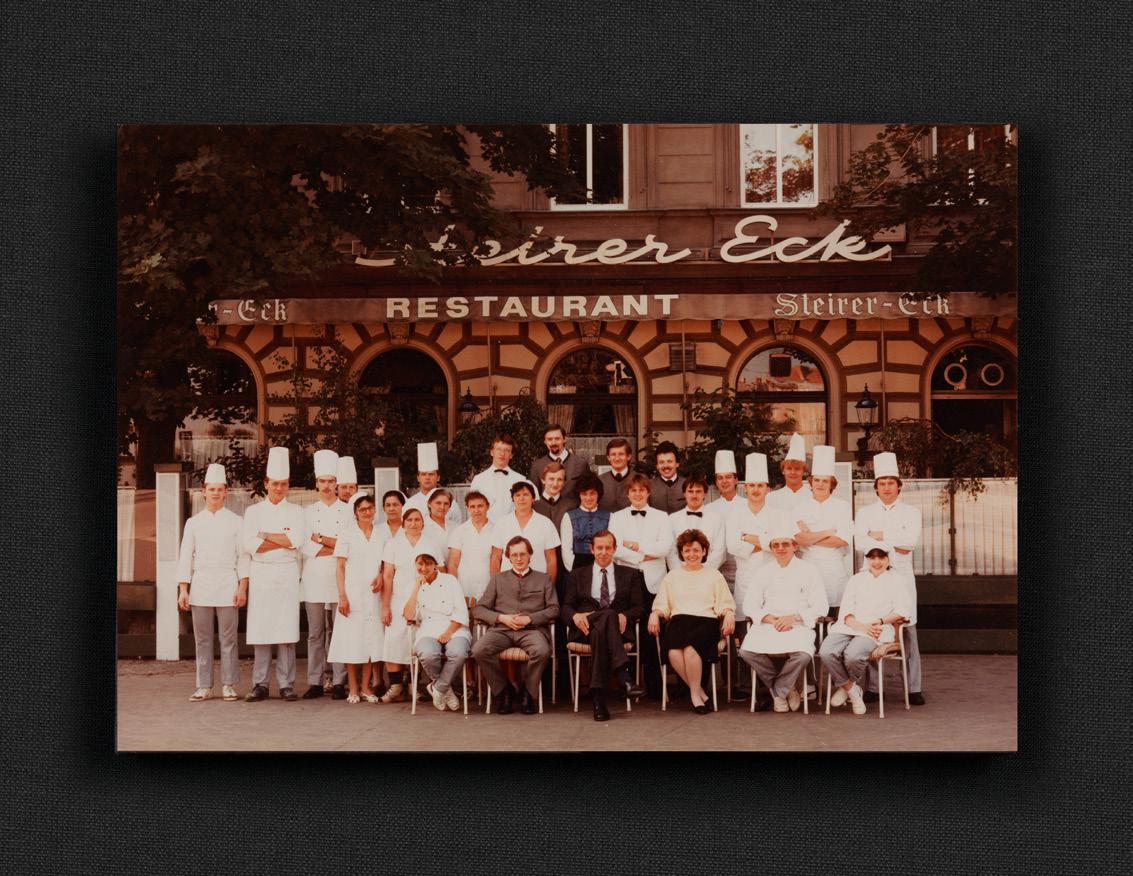
50 YEARS OF STEIRERECK –A JOURNEY THROUGH TIME
TEXT: MICHAEL HUFNAGL, PHOTOS: STEIRERECK ARCHIVE, REPRODUCTION: KLAUS FRITSCH
THE SUCCESS STORY OF GOURMET ART
BEGAN IN 1970 WITH A RUSTIC INN.
64 S MAGAZIN REAR VIEW
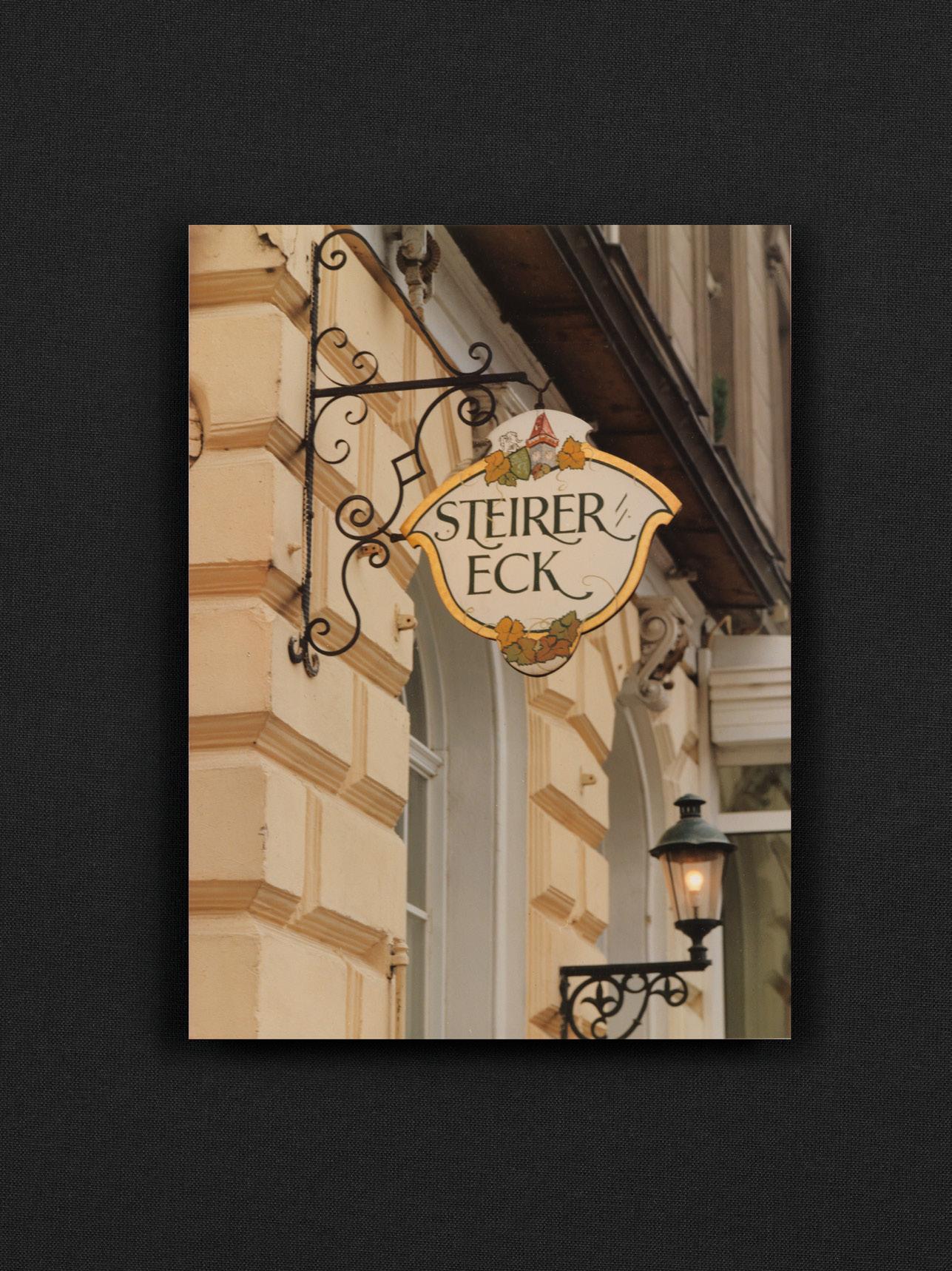
65
01-02 Styrians, who developed a Viennese corner inn over decades into a refuge of enjoyment. In the 1980s, Margarethe and Heinz Reitbauer assembled their successful team for a group photo.

“Love is the most important seasoning”, Justine Kirchengast used to say. The passionate cook – Heinz Reitbauer’s grandmother – put the Steirereck’s recipe for success in a nutshell; much better than any eulogy cooked up by the media over the past five decades. Short and sweet. So – love.
It sounds simple, but of course that is not all there is to it. Love of cookery is one thing. But a much praised restaurant also needs relentless trying, experimenting, a knowledge of produce and product, a love of esthetics, attention to detail, a love of service and team spirit, courage, and continuous development, a vision.
The many toques and stars which Steirereck has garnered over the years, and which define it (much as the breading defines a Wiener Schnitzel), are in that sense proof of that love. Although that is one of those sentences Heinz Reitbauer does not like to read in his own magazine. For him, understatement is essential.
No matter how much praise is lavished on him and his culinary art, Reitbauer is not tempted to flirt with grand airs. But for this 50-year-anniversary, the
pre-eminent Ambassdor of cuisine in Austria will have to tolerate the spotlight for a bit.
In 2005, after nine successful years on the Pogusch mountain pass, Heinz Reitbauer (“We treat a potato with the same care as caviar”) took over the Steirereck kitchen from Helmut Österreicher, who in 28 years of loving care had turned a simple inn into a gourmet paradise.
That same year, the restaurant moved from Rasumovskygasse to Vienna’s Stadtpark. The new location was only a fifteen-minute walk away, but propelled Steirereck into a completely new dimension. The Steirereck “Meierei” (“creamery”) was a welcome (and worthwhile) addition to the gourmet concept.
In 2014, large scale refurbishments took place; a bigger wine cellar, a modern pavilion building with a mirror façade were added. The first issue of S Magazine was published at the official opening in June. But the number of seats stayed the same. 90 people can be acccommodated and fed. The refurbishment was not about scale, or expansion, it was about optimising and quality; something in which the family firmly believes.
66 S MAGAZIN REAR VIEW
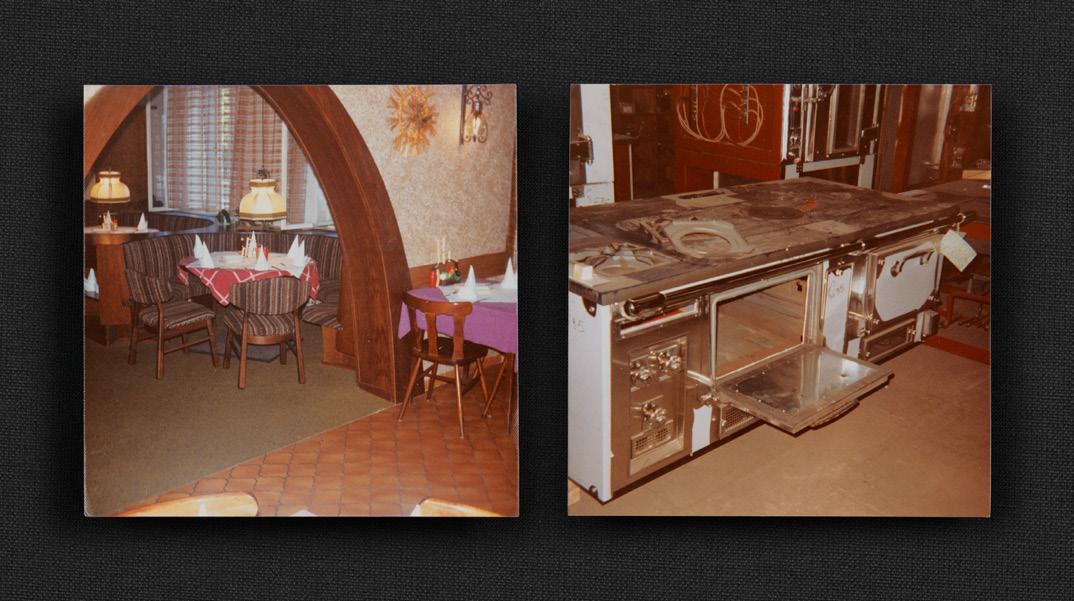
Nothing is closer to the Reitbauers’ hearts than the desire for improvement. And anyone lucky enough to hear Heinz senior and his wife Margarethe describe their will, their actions, and the emergence, will listen closely. How they describe their resolution to leave Turnau in Styria for Vienna – in spite of their determination to go anywhere but there. How they describe their epiphany, the idea which was to become the i underneath the dot, so to speak. No surprise then, if, 50 years on, any author immediately thinks “Dare to Dream Big”.
“My mother was incredibly gifted, she would doubtless have been awarded four toques”, says Heinz senior in an Ö1 radio broadcast made for the Steirereck’s 30th anniversary. “Although she never wrote down her recipes; she had it all memorised. Went by intuition.” This certainty, combined with his growing up surrounded by a farm, a butcher’s shop, and an inn, turned the young man into a visionary. Together with the “sassy lass” Margarethe (they were married in 1968), who also possesses gastronomical roots, they started out in their native Styria: He managed the skittle alley at Sonnenhof, she took care of the bed and breakfast. This was before they decided to create their own luck, by following their very own dreams.
In the capital, of all places, Heinz found a restaurant with a open air terrace at the corner of Rasumovskygasse and Weißgerberlände, where people sat to drink a beer and eat goulash, “on a Wednesday at 4 pm. That was incredible, I had never seen anything like it before.” And if you have a gut feeling, you tell yourself, “That’s it!” Seen. Admired. And bought.

03-06 From 1996 on, Pogusch (left) became a much praised outpost; also because of its beautiful surroundings. But it all started on 1 January 1970, with a rustic inn. The same year that Heinz junior was born. Before he discovered the art of cuisine as a young man. Top right: the first kitchen range at Steirereck.
67

S MAGAZIN 68 REAR VIEW

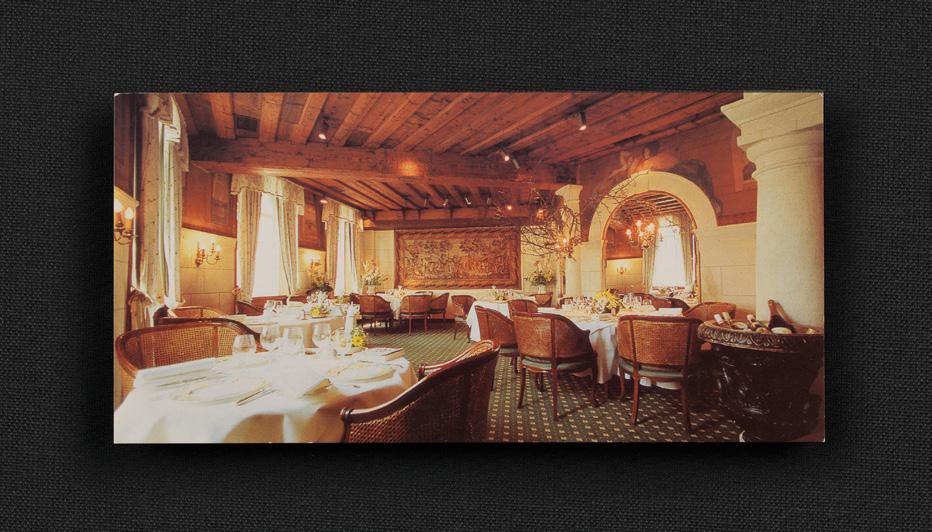
07-09 Over the course of 28 years, Helmut Österreicher created a gourmet paradise. A handwritten menu from the past serves to illustrate his way of rethinking culinary art. Steirereck after refurbishments turned it into the best place for a gourmet rendezvous.
69

On 1 January, 1970, Steirereck opened. “The Reitbauer name would have been too unwieldy, too unknown, so we combined “Steirer” for Styrian and “Eck” for corner.” The motto: Large portions, small prices. “The schnitzels were bigger than the plates,” Heinz recalls. “From the beginning, we had many customers,”, says Margarethe. “We were both in the kitchen, although we did not have professional training as a chef. We wanted it badly. And we didn’t sleep more than five hours a night.”
Initially, there were two menus to choose from, one for 14, the other for 16 schillings. Liver dumplings and goulash, loin and fries, and every Friday – a real hit with the guests – vegetable soup and yeast dumplings. Simple fare. “People liked us,” they both say. For five years, their gastronomical self-realisation worked so well that Heinz was able to buy a Mercedes and some land in Turnau.
Until that holiday in 1975. Which changed everything. A holiday, whose memories still linger in Steirereck. At that time, the couple visited the best restaurants from Milan to Brussels to Paris. And they discovered that the tradition they cultivated so successfully, was as far removed from gourmet life as a hot dog from a filet mignon.
“We discovered that we had nothing over a hot dog stand,” smiles Margarethe. And Heinz adds, “We knew we needed to change something. Not something … everything.” It was about liberation, and about satisfaction. And so Heinz got rid of the deep fryer he had just bought for 45.000 schillings. After all, “a proper schnitzel is cooked with butter oil in a frying pan.”
In 1972, the Reitbauers had invested into rustic decor; in 1980, after years of careful development (“Indian Rice Platter, Piccata Milanese, Saltimbocca”), they ripped everything out and started with a clean slate. Prior to that, they had engaged the services of Adi Schmid as sommelier in 1976 – Schmid was to stay for 41 years –, and in 1978, they had advertised for an innovative junior chef (“Because if you hire an old hand, you have to make him unlearn everything”), and they had found Helmut Österreicher. Says Heinz Reitbauer, “All of a sudden, we were buying fresh produce. In reality, we had merely been working as tin openers.”
The new chef was sent abroad, to be inspired. Reitbauer’s summary: “You have to devour a house in order to get a sense of taste.” The investments have certainly paid off. After a brief interlude, where
70 S MAGAZIN REAR VIEW

guests complained that there was no Cordon Bleu on the menu anymore, and after one scathing review of their Nouvelle Cuisine in the 1981 Gault-Millau (“the criticism was good for us”), Steirereck received its first toque in 1983.
In 1984, Adi Schmid received “Sommelier of the Year”, in 1986, they were awarded their second toque, in 1987, Herbert Schmid won “Cheese Sommelier of the Year”, in 1988, Helmut Österreicher was made “Chef of the Year”. 1992 proved especially successful: Steirereck was awarded 19 out of 20 Gault Millau Points and four toques; an absolute first for Austria. “People were practically wailing when we took our starter and dessert carts off the menu, but at the end of the day, we knew that to be successful, we had to, have to continually change something.”
It could be something like the Pogusch idea: from 1995 onwards, the restaurant on the eponymous mountain pass became a successful country outpost. By now, Heinz junior has been awarded two toques for his cooking. His father, who in his Styrian homeland is associated with the Pogusch style, and who has shaped the culinary landscape of Austria, likes to say, “As society is changing, gastronomy has a bright future.”
Heinz junior, who can be relied upon to praise his colleagues, who furthers talents, who was made “Chef of the Decade” three years ago, has internalised this attitude. With Birgit, who agreed in 2002 to be his wife and who is soul and face of the entire operation, he has the same creed as ever, “Never stay still.” No 50th anniversary can change that, not the restaurant’s in January, nor his own birthday in August. The German newspaper, FAZ, once wrote about Steirereck, “A magic culinary kingdom, which no State Opera designer could have made more beautiful.” Apt words for the big anniversary.

10-12 Adi Schmid, sommelier at Steirereck for 41 years. In 2005, Steirereck moved to Stadtpark, after largescale renovations. The Reitbauer Family: Margarethe & Heinz Reitbauer senior with Birgit & .Heinz junior.
71
FOOD AND BUSTLE
TEXT: POLLY ADLER
Why food is the best cement in love and really any kind of
relationship.
Long before Ikea, I felt Swedish inside. For Bullerby and Lönneberga were places where mothers made sausages, where little sisters were hoisted on flagpoles, and where the days before a holiday were spent in manic preparations. People pickled, marinated, baked, braised, and stewed; they stirred red fruit jelly and smoked reindeer haunches for all they were worth. I loved Astrid Lindgren’s universe, not least for her orgiastic sense of banquets, a universe where children lived in a wonderful blend of security and freedom. The overflowing family table, during holidays surrounded especially by those who under normal circumstances perhaps do not especially like each other, the family table manages what seems practically impossible: it simulates unity and harmony, at least for certain periods, while everyone eats themselves fit for the sofa, preferably accompanied by deep sighs of satisfaction, otherwise heard only when engaged in “the most fun you can have without laughing” (Woody Allen).
Throngs of sociologists, psychologists, cultural historians, and theorists of everyday life have mused about how much a communal meal can whisk you from everyday life to a hedonistic safe place, how important communal eating is as glue in relationships, and as a social playground. “If we don’t eat together, we lose safety and security”, writes psychologist Marshall Duke, “eating together is the backbone of human interaction.”
Eating also functions as a diversion and can be used to diffuse conflicts. Over the course of his research, Duke found that 30 percent of conversations at dinner are about the food on the table. In this way, inheritance disputes, diplomatic problems, or mere resentments and unhappiness could evaporate in the heat rising from the steaming plates, at least for a while.
At this point, one must indulge in a brief lament about the downfall of culture as we know it, demonstrated by more and more people getting their food by clicking on their Foodora App, claiming the ritual of cooking is a waste of time. These are the very same people who suffer from food pornitis, who post, post, and post again images of their restaurant meals, and then watch the number of likes rise, while they unthinkingly hoover their food.
A short while ago, my daughter moved to Berlin. I now live alone. “Do you still cook for yourself?”, I am often asked. And how! Of course! Cooking has something to do with loving care, which one should not neglect, not for others nor oneself. Of course it is more fun to fry and cut for a motley crew. Most times I find myself still in a dishevelled state by the oven, as the first guests arrive, inquiring, in a pitying tone, “Can we help you?” Heavens, no.
72 S MAGAZIN MEAL TIMES
When my beloved grandmother died in her 96th year, she went as I would like to go: She was frying potatoes for the family as she fell in front of the oven. It does not get any better than that. Grief hit me hard, and I began to invite friends and cook like a woman possessed. A Bolognese sauce for instance, which has to simmer for three hours, offers perfect consolation in such circumstances.
I received my proper hedonist training in different countries and by master eaters. I thank my mother for sending me in my late teens to Italy and France as an au pair slave. It is impossible to forget those Sunday feasts in France, which started around two and ended at dusk. Every new course was fêted with shouts of delight, like a goal after a penalty kick: It was a celebration of life. Incidentally, the French won’t be disturbed at weekday lunchtimes either –eating to them is a sacred service. Restaurants are crowded, tables are densely populated, and the hectic quest for self-improvement seems suspended between the hours of one and three. In spite of this, French women are blessed with fragile figures, allegedly due to their alleged diet at home: They are said to subsist for days on one tiny pot of skimmed yoghurt and individual leaves of lettuce. But they don’t let on to the world at large. Standing in line at the cash desk of a Paris Museum at lunchtime, I once commented how one might reduce the queues by opening another register. The woman in her glass enclosure gave me a look as if I had dropped in from a jungle liana, a wild thing with no culture whatsoever, and informed me, voice dripping with disdain, “Madame, it is the Hour of the Meal”.
On an old farm in Italy’s picturesque Valpolicella region, my au pair employers taught me the love of produce. We caressed herbs together. I plucked tomatoes in the garden, and puréed them with the help of a “Flotte Lotte” food mill, until my biceps were the size of ostrich eggs. We knew the first names of the pigs and sheep, whose haunches and filets we braised in large copper pots in the kitchen, which boasted a chimney from the Renaissance. Should anyone ask me on my deathbed about the most divine combination of tastes I had ever sampled, I would answer without hesitation, a piece of ripe pear, a slice of boar salami, served on a hot slab of polenta straight from the wood-fired oven, washed down with ice cold white wine.
To satirist and author, Werner Schneyder, food was a religion; in consequence, he was an excellent teacher. A hedonist through and through, the kind you only seldom meet, he was one of those rare people who can rave about coming meals while they are partaking in a feast. He said, happily and often, he owed this to his beloved grandmother, Anna Berzkowitsch. Accordingly, his highest praise for his hosts’ food was, “This approaches Anna Berzkowitsch!” Here is to our grandmothers, who refined our tastes.
Mr Schneyder, by the way, deigned to depart from this earth last March, after consuming a scorpionfish accompanied by copious amounts of white wine. It was a five star death for this master eater. Friedrich Torberg’s saying, “Eating was his favourite food” would have made an ideal epitaph for his headstone.
73
The woman behind Polly Adler, columnist for the leisure supplement (“Freizeit”) of the Kurier newspaper, is ANGELIKA HAGER ; she heads the society section of “profil”.
SYMPHONY
“JOY is the strong spring of eternal nature. Joy, joy, drives the cog wheels of the great clock, the world.” Thus wrote the great Friedrich Schiller in his “Ode to Joy”. And whoever reads this poem with the right freedom of mind, may well believe that the culinary art is accompanied
 EDITOR: MICHAEL HUFNAGL
EDITOR: MICHAEL HUFNAGL
74 S MAGAZIN FOOD ORDER
SYMPHONY

by Götterfunken, a divine spark.
Ludwig van Beethoven turned these words into music, and his Ninth Symphony has become an expression of optimism and joy everywhere. So why not call an opulent dinner a Sensual Symphony, a Symphony of the Senses?
PHOTOS: THOMAS SCHAUER
75
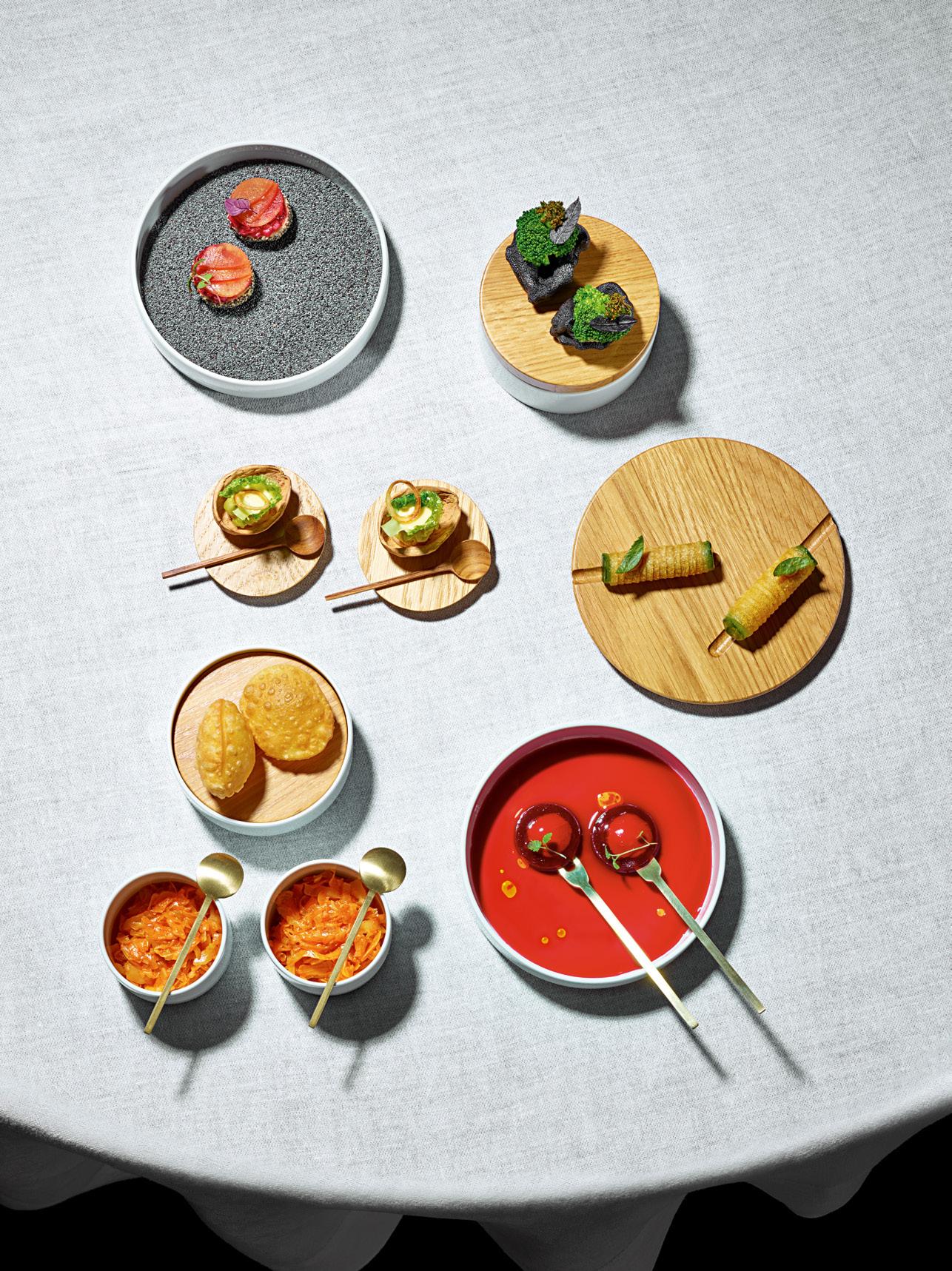
76 S MAGAZIN FOOD ORDER
A JOURNEY THROUGH AUSTRIA AND BEYOND
1 Yeast dumplings with salted prune, poppy seed & perilla mint
2 Fermented vanilla sprouts with walnut & parsnip
3 Rösti with pike's liver & horseradish leaf
4 Forono beet with soured cream
5 “Blattln mit Kraut”
6 Brokkoli with Meyer lemon & walnut leaf
GASTRONOMIC CULTURE:
Over the course of the centuries, Austria has developed a multi-faceted culinary identity. Rooted in the k.u.k. monarchy, and owing to the many influences of the crownlands and various kingdoms in its realm, it developed into a multinational cuisine with different regional specialities. It is impossible to reduce it to a mere handful of dishes or regions. Many of the tastes, products, or preparations can now be traced to a certain region. The many different tastes connect us across borders, to our families and our history. They are a reflection of our culture, our lives. A journey through Austria and beyond.
By the way: The Viennese cuisine is the only one in the world bearing a city name. It originated over 200 years ago, during the Vienna Congress, on Viennese stoves, with the different cuisines peacefully sharing their traditions and tastes. Thus began the reputation of the Viennese cuisine.
“BLATTLN” (SMALL “LEAVES”), 12 PORTIONS
INGREDIENTS
- 250 g flour (smooth)
- 55 g butter (room temperature)
- 1 organic egg yolk
- 100 ml milk
- 1 p inch of Carpathian salt
- flour to roll out the dough
- 50 % butter fat - 50 % vegetable oil
PREPARATION
Mix the ingredients, slowly add the milk. Knead into a homogenous dough. Wrap in clingfilm and leave to rest for 60 minutes at room temperature.
Roll out the dough on our floured flat surface until it is 2 mm thin. Use a 4 cm biscuit cutter to cut discs of dough.
Heat the butter fat and vegetable oil together and bake the “blattln” in the fat.
Tip: Turn the pot continuously and pour fat over the dough to ensure an even rising.
Lift the “blattln” from the pan, and leave to drip on kitchen paper.
Serve immediately.
77
Recipe

78 S MAGAZIN FOOD ORDER
MARCHFELD ARTICHOKES WITH POPPYSEED, PEACH & RUSSULA
1 With poppy & madeira braised, deep fried & glaced artichokes with poppy–miso
2 Long beans with verbena & peach
3 Steamed russula mushroom caps
4 Sauteed, preserved ‘Vigamor’ shallots
5 Artichoke – blue poppy seed sauce
Wine 2010 Ex Vero I (SB, CH), Werlitsch-Ewald Tscheppe / Leutschach, Südsteiermark
RUSSULA:
Around 750 worldwide species of ectomycorrhizal mushrooms compose the genus Russula. They are typically common, fairly large, and brightly colored – making them one of the most recognizable genera among mycologists and mushroom collectors. Their distinguishing characteristics include usually brightly coloured caps, a white to dark yellow spore print, brittle, attached gills, an absence of latex, and absence of partial veil or volva tissue on the stem.
Collected by Florian Kogseder for Steirereck.
GREY POPPYSEED-MISO, 12 PORTIONS
INGREDIENTS
- 23 g grey poppyseed oil (Gressl)
- 7,5 g garlic (peeled & finely chopped)
- 5 g ginger (peeled & finely chopped)
- 230 g shallots (peeled & finely chopped)
- 1 pinch of chili, red, fresh (finely chopped)
- 400 ml poultry stock
- 125 g light miso
- 1/2 lime (zest & juice)
- Carpathian salt
PREPARATION
Glaze the garlic, the ginger, and the shallots for 15 minutes at medium heat in the grey poppyseed oil.
Add the chili and the crushed grey poppyseeds, leave them briefly in the mix.
Unglaze with the poultry stock, stir in the miso, and cook everything for 50 minutes at medium heat.
Purée to a smooth paste for ten minutes in the Thermomix at its highest setting.
Season to taste with Carpathian salt, and lime zest and juice.
Recipe 79

80 S MAGAZIN FOOD ORDER
Recipe
SMOKED EEL WITH YOUNG CARROTS, KALE & MEYER LEMON
1 Lake Bodensee smoked & flamed eel with glazed young carrots
2 Kale & Meyer lemon cream
3 Oxheart carrot & kale salad with hemp oil
4 Young carrots braised with smoked eel, ginger & cape gooseberries
5 Pickled small onions
6 Ice cristal salad marinated with hemp oil
7 Crispy kale
8 Soured buttermilk
Wine 2016 Welschriesling “Saybritz”, Franz Weninger / Horitschon, Burgenland
“OXHEART ” CARROT:
An intensely flavoured heirloom carrot.
From Michael Bauer, Stetten / Lower Austria
INGREDIENTS
- 400 ml Tonic Water (Schweppes)
- 2 0 g Ginger (peeled & sliced)
- Carpathian salt
- Crystal sugar
- 300 g Pearl onions (small)
PREPARATION
Cool all ingredients together, and bring to the boil once.
Halve the pearl onions, peel them. Add them to the hot marinade, bring everything to the boil once. Fill in preserving glasses, while still hot. Seal and keep cool until needed.
81
PICKLED PEARL ONIONS, 12 PORTIONS

82 S MAGAZIN FOOD ORDER
CRAYFISH WITH TOMATOES, MONARDA & OLIVE HERB
1 Crayfish glazed with crayfish stock
2 Preserved, semi dried tomatoes
3 Tomatoes marinated with crayfish stock
4 Tomato inner marinated with balsamic vinegar & olive herb oil
5 Celery-cucumber-apple salad marinated with mustard seeds, monarda & olive herb
6 Monarda blossom & monarda tips
7 Crayfish sauce
Wine 2012 Riesling “Wunderburg”, Pichler-Krutzler / Oberloiben, Wachau
MONARDA:
A wildflower of the mint family Monarda is widespread and abundant as a native plant in much of the Northern Hemisphere. It has summer–blooming, nectar rich edible flowers and has been used as a medicinal plant by the native Americans for centuries. Monarda is still used today as the natural source of the antiseptic thymolt, the primary active ingredient in modern commercial mouthwash formulas. From the Steirereck Garden.
SALAD OF CELERY, CUCUMBER, AND APPLE, 4 PORTIONS
INGREDIENTS
- 25 g Santolina
- 250 ml Grape seed oil
- 2 00 ml Verjus of red grapes
- 4 g Wild monarda blossoms
- 2 00 g Apples (peeled & finely diced)
- 2 00 g Cucumber (peeled & finely diced)
- 100 g Celery (peeled & finely diced)
- 100 ml Verjus of monarda
- 40 g Santolina oil
- 2 TL Celery greens (julienne)
- Li me zest & -juice
- C hili oil
- Cayenne pepper
- Carpathian salt
PREPARATION
Santolina oil: Vacuum-seal the santolina with the oil. Squeeze gently to release the essential oils. Cook for two hours in a bain-marie at 67 °C, then leave to infuse for 48 hours in a cold store. Strain and store in a dark and cold place.
Verjus of monarda:
Vaccum-seal the verjus and the cleaned blossoms (setting 7) and cook for 30 minutes in a bain-marie at 72 °C. Leave to cool, and store sealed in a cold place until needed.
Prepare the salad:
Mix all ingredients and season to taste.
Recipe 83

84 S MAGAZIN FOOD ORDER
VENISON HEART WITH GRAIN, SHEATED WOODTUFT & MUSHROOM PLANT
1 Confitted heart of venison withfermented, dehydrated forono beets
2 Steamed, fluffy grain with crispy linseeds
3 Boiled, fermented and dried sheated woodtuft
4 Roasted venison broth
5 Mushroom plant oil
Wine 2013 Furmint “Garten Eden”, Michael Wenzel / Rust, Neusiedler See-Hügelland
SHEATED WOODTUFT:
This species always grows on wood, generally on stumps of broad leaved trees (especially beech, birch and alder), and rarely on conifers. It is found from April to late October, and also in the remaining winter months where conditions are mild. It is often seen at times when there are few other fungi in evidence. From Florian Kögseder / Upper Austria
CRISPY LINSEEDS, 10 PORTIONS
INGREDIENTS
- 50 g Linseed
- 500 ml Water
- Vegetable oil (for deep-frying)
PREPARATION
Soak the linseed in water for 24 hours.
Note: The linseed will form a slimy layer around the grain and will swell by about 1/3 of their size.
On the next day, thoroughly drain the seed through a hair sieve. Heat the oil in a high casserole to 180° C and fry the seed in small portions in the sieve.
Tip: Due to the slimy layer, the linseed will stick together when you begin to deep-fry. Use a wooden spoon to stir the linseed in the sieve to ensure that the surface is evenly fried.
85
Recipe

86 S MAGAZIN FOOD ORDER
Recipe
‘SCHNEEBERGLAND’ DUCK WITH ENOKI, ELDERFLOWER & LAVENDER
1 Whole roasted ‘Schneebergland’ duck breast with coriander & lavender
2 Enoki mushrooms confited & grilled
3 Duck tongue salad with yuzu
4 Preserved red meat radish with elderflower
5 Enoki Cream
6 Duck sauce with lavender
Wine 2012 Cornas “Billes Noires”, Domaine du Coulet – Matthieu Barret / Rhône
‘SCHNEEBERGLAND ’ DUCK:
Eight week old Peking ducks from ‘Schneebergland’/ Lower Austria.
VELVET STEM / WINTER / ENOKI MUSHROOMS:
In season from October to April these small, firm, mild tasting mushrooms contain a protein which protects the cells against frost.
RED MEAT RADISH MARINATED IN ELDERBERRY, 12 PORTIONS
INGREDIENTS
- 2 pieces of Red meat radish
- 180 ml White Balsamic vinegar (Gölles)
- 100 ml Elderflower syrup (Steirereck)
- 70 ml Lime juice
- 1/2 piece Lemon grass (crushed & cut)
PREPARATION
Peel the radish, cut into thin discs.
Cook all other ingredients, bring to the boil and pour over the radish. Vacuum-seal immediately and stored cool until needed.
87

88 S MAGAZIN FOOD ORDER
Recipe
‘SCHAFNASEN’ APPLE & ALBATRELLUS OVINUS WITH BALM & CHESTNUTS
1 With balm & meyer lemon preserved styrian ‘Schafnasen’ apple
2 Steamed albatrellus ovinus with fermented & jellied maple syrup
3 Heymilk royal
4 Crunchy chestnuts
5 Dried ‘Kletzen’ pear
6 Apple–balm sauce
7 Roasted chestnut oil
Wine 2017 Trois Pepins, Cidrerie du Vulcain – Jaques Perritaz / Schweizer Jura
‘ SCHAFNASEN ’ APPLE:
This apple used to be the favourite of Erzherzog Johann. It’s thin and coneshaped.The coulour is white to green and this unique apple has a sweet sour flavour. Unfortunatly this autum-winter apple is rarely available. From Fam. Kirchengast / Styria
ALBATRELLUS OVINUS:
This mild mushroom has a white to cream coloured flesh, which becomes yellow while cooking. It grows from July to November in mid to high mountainius regions under spruce & pine trees.
STYRIAN ‘SCHAFNASEN’ APPLES MARINATED IN MELISSA & MEYER LEMON, 12 PORTIONS
INGREDIENTS
- 2500 ml “Donnerwetter” (Wetter apple-pear juice)
- 22 g Large Meyer lemon, zest
- 350 ml Apple schnapps
- 2500 ml Water
- 75 g Zitronenmelisse (fresh) - 7 g Verbena tea (dried)
- Schafnasen apples (Pogusch)
PREPARATION
Marinade: Boil together and leave to brew for 20 minutes.
Bring to the boil and flambé, until the alcohol has evaporated. Add to the marinade.
Melissa tea: Boil water, roughly chop the melissa with its stalks. Leave melissa and verbene to steep for five minutes in the water, then drain through a hair sieve and add to the marinade.
Let the marinate cool to room temperature.
Peel the apples and halve them with their stems. Remove the core with a 20 mm Parisienne cutter.
Tip: Place the apples immediately after peeling in the cold marinade to avoid oxidation!
Place the pitted apple halves in large vacuum bags and vacuum-seal with the apple marinade.
Steam small quantities at 100 °C for 18 to 25 minutes. Place them in ice water immediately afterwards.
Tip: Cooking time depends very much on the size of the apples. Make sure you vacuum-seal similar sizes to ensure even cooking.
89
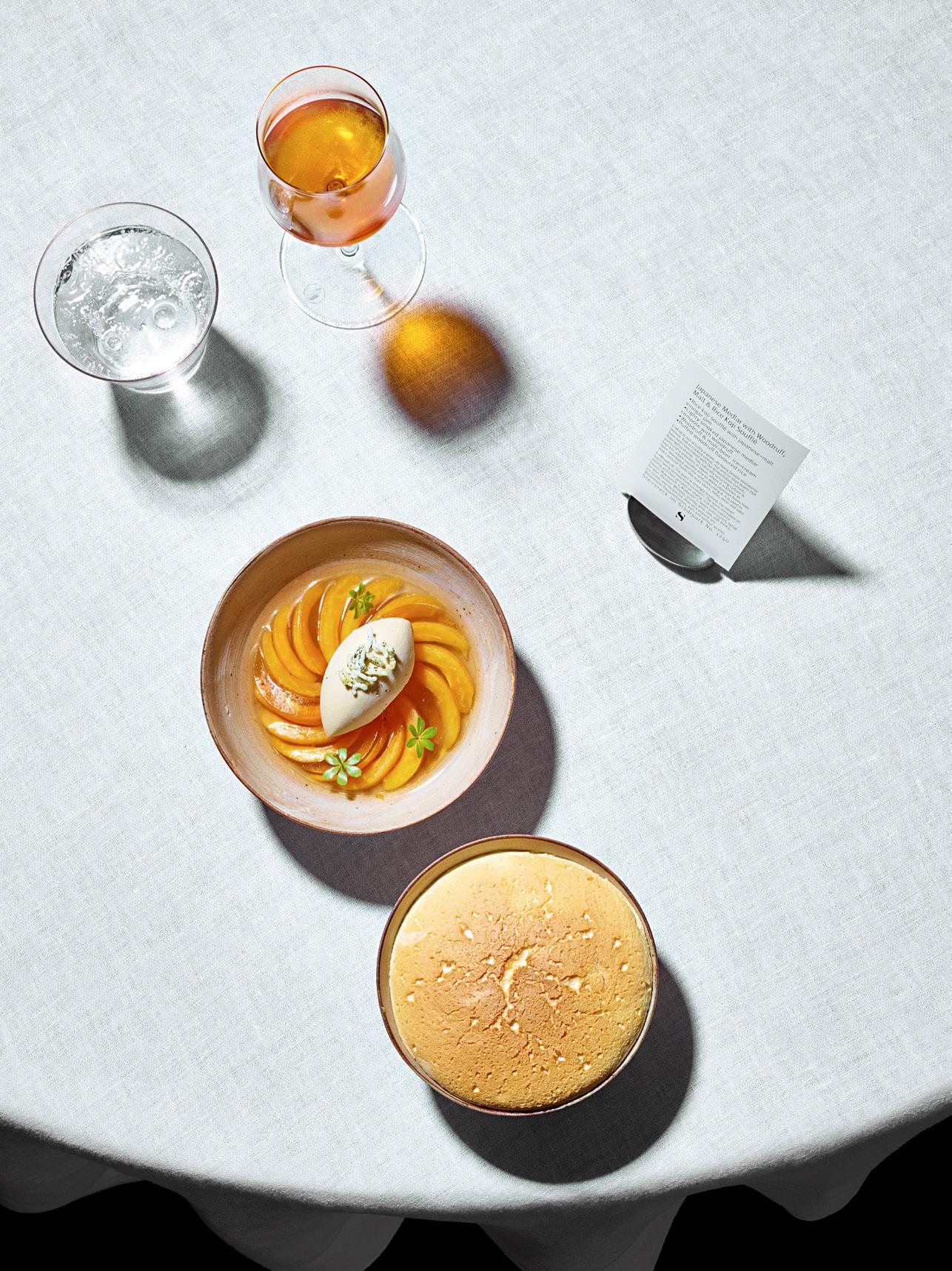
90 S MAGAZIN FOOD ORDER
Recipe
JAPANESE MEDLAR WITH WOODRUFF, MALT & RICE KOJI SOUFFLÉ
1 Rice koji soufflé with japanese-malt vinegar jam
2 Lighty smoked japanese medlar compote with woodruff
3 Woodruff & malt–beer ice-cream
4 Puffed woodruff flavoured rice
Wine NV Sercial “10 Years aged – Reserva Velha”, Barbeito / Câmara de Lobos, Madeira
KOJI:
Koji is not actually a yeast, as many people mistakenly believe. Koji is cooked cereal, rice and/or soya beans that have been inoculated with the fermentation culture, Aspergillus oryzae. This naturally occurring culture is particularly prevalent in Japan, where it is known as koji–kin, which explains why so many Japanese foods have been developed over the centuries using it. It is used to make popular foods like soya sauce, miso, mirin and sake.
WOODRUFF:
The plant is strongly scented, the sweet scent being derived from coumarin. The scent increases on wilting and then persists on drying. It is often used to flavour May punch (“Maibowle”), sweet juice punch, syrup for beer (Berliner Weisse), brandy, jelly, jam, soft drinks, ice cream, and herbal tea. Also very popular are Waldmeister flavoured jellies, with and without alcohol.
WOODRUFF AND MALT BEER ICE CREAM, 12 PORTIONS
INGREDIENTS
- 100 g Malt beer
- 500 g Organic hay milk
- 200 g Cream
- 50 g Malt beer reduction
- 15 g Woodruff
- 112 g Crystal sugar
- 20 g Glucose
- 250 g Organic hay milk
- 52 g Maizena (corn starch)
- Woodruff and malt beer ice cream basis
- 87 g Yoghurt
PREPARATION
Malt beer reduction: Boil down to half.
Woodruff and malt beer ice cream basis:
Boil all ingredients together and leave to steep for at least two hours. Mix milk and Maizena.
In the meantime, bring the ice cream basis to the boil, thicken with the milk-Maizena mix.
Tip: Maizena needs several minutes of cooking time to lose its starch taste.
Mix the yoghurt with the cooled ice cream and pass through a sieve. Finally freeze in the ice machine.
91

92 S MAGAZIN FOOD ORDER
Recipe
CITRUS FRUITS FROM THE SCHÖNBRUNN PALACE WITH WILD BERRIES
1 Gin Fizz with Meyer Lemon & Bitter Orange Blossom
2 Pomelo with Cornell Cherries – Citrusherb’s Sugar
3 Elderberries & Viennese Eucalyptus with baked Curd Dumpling
4 Rose hip Sorbet with Bergamot
5 Jaina Chocolate with Sea Buckthorn
6 Candied Citrus Fruits from the Schönbrunn Palace
7 Rowanberries & Verbena with frozen Lemon from Schönbrunn Palace
GIN FIZZ WITH MEYER LEMON & BITTER ORANGE BLOSSOM, 24 PORTIONS
INGREDIENTS
- 250 g Large Meyer lemon, juice (strained)
- 150 g Bitterorangenblüten-Sirup
- 150 ml Bombay Sapphire Gin
- 150 g Egg white (pasteurised)
- 130 g Lemon juice (strained)
- 70 g Bombay Sapphire Gin
- 145 g Simple syrup 1:1
PREPARATION
Cold Fizz:
Mix everything, freeze and blend when frozen. Store in a freezer until needed.
Fill the frozen, blended mass into a pre-frozen mortar.
Hot lemon mousse:
Break and beat the egg white with a whisk.
Funnel the remaining ingredients into a seltzer bottle. Fill with two gas chargers, shake well and place in an 80 °C bain-marie.
93

NOBLE DRINK 94 S MAGAZIN
“ WELL, WELL.” “Awesome.” “WOW.”
TRANSCRIPT: SEBASTIAN HOFER
PHOTOS: PHILIPP HORAK
WINE DESCRIPTIONS: RENÉ ANTRAG

Steirereck turns 50. The perfect occasion for Adi Schmid and his successor René Antrag to sample wines from five decades and to philosophise – about the Neolithic of the Schilcher grape, about locked-in cellarmasters, stressful choosing of wine accompaniments, and the return to nature – and much else besides.
01–02 René Antrag and Adi Schmid contemplate five decades of Austrian wine history.
95
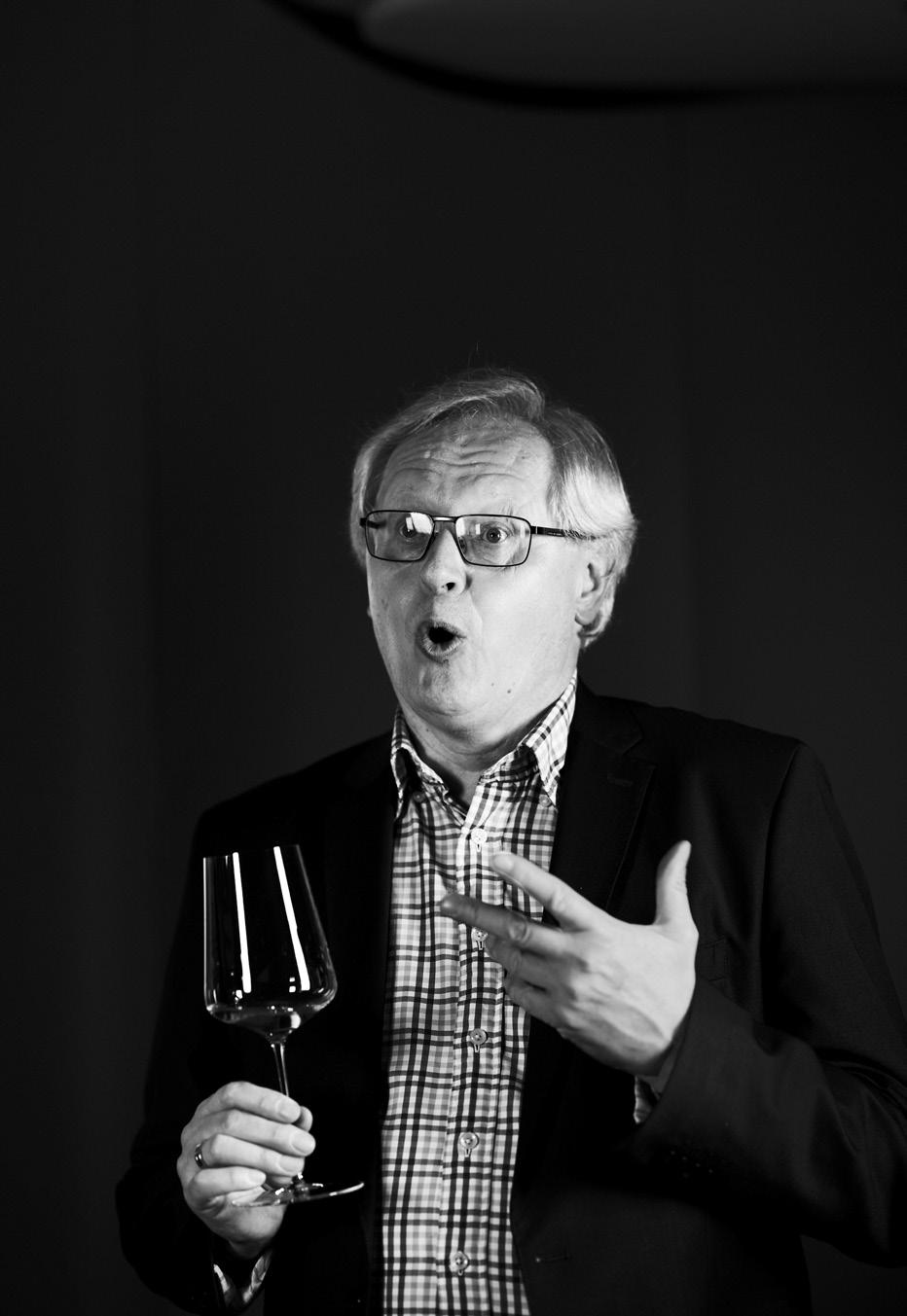
96 S MAGAZIN NOBLE DRINK
03 For over 40 years, Adi Schmid worked at Steirereck, most of the time as head sommelier. He says he became “more subdued” after his retirement in 2017.
It is late afternoon in the beginning of November, the hour of Steirereck legends. Adi Schmid, who worked here from 1976 to 2017 and most of that time as chief sommelier, opens a few bottles, together with his equally gifted successor, René Antrag: great, important, formative Austrian wines from five decades, history behind glass, literally. First up a 1989 Grüner Veltiner Hoher Rain, Geyerhof, Kremstal.
ANTRAG I have had the pleasure of sampling several mature wines of Geyerhof. They have a wonderful old cellar, with rare and exquisite wines.
SCHMID Ilse Mayer was once wine queen.
ANTRAG This wine still radiates!
SCHMID At that time, they added more sulphur, that has that effect. I have a book by Lenz Moser, in which he recommends adding sulphur. Nowadays, you would go to prison for suggesting that.
ANTRAG Mr Schmid can probably tell you more about the 1970s and 1980s than I could.
SCHMID I could also talk about the 1960s. And about the current status quo.
ANTRAG Because you are on it.
SCHMID Though I have become a little more subdued. Since my retirement, I have been tasting wines for a supermarket guide. Which made me discover humility. During my time at Steirereck, I think I was a little bit arrogant.
ANTRAG Beg your pardon?
“There are no more faulty wines today. They are clean, clear, precise.”
SCHMID You don’t notice yourself. But when a winegrower brings you a classic Sauvignon, you tell him: Thanks, but no thanks. Meanwhile, as I have tasted many lesser known wines, I have come to know that there are good ones among them.
ANTRAG Well-made wines.
SCHMID Not just well-made. They are good wines.
ANTRAG Wine-making technology is so advanced, that there are no faulty wines anymore. They are clean, clear, and precise. There are all these aids: coole steel vats, cultured yeats, wood chips.
SCHMID At the same time, there is more knowledge out there, about the right time to harvest, matching grape types and soils. What made a great wine? It was sheer luck. Up until the mid-1970s, wines came from mixed farms. People had cows, pigs, grain, potatoes – and a vinyard. The vinyard suffered from being last in that enumeration. When everything else was harvested, they went and harvested the grapes. If it was a good year, the wine could turn out great. Or not.
ANTRAG Many wine-makers nowadays go back to mixed farming. Like Geyerhof, or Ernst Triebaumer. They are going back to the roots.
SCHMID And that is good. But I won’t denounce the interim developments – the barrique hype, in international varieties, Cabernet, and so on. If that had not been done, we would not be where


1989 GRÜNER VELTLINER
“ HOHER RAIN ” KABINETT, GEYERHOF / OBERFU CHA
A Veltliner, which mirrors the acicity of that year, it plays with lime, yeast, white blossoms with a fine flavour. A purist wine of soft notes.
1988 CABERNET SAUVIGNON / MERL OT, JOHANNESHOF-REINISCH / TATTENDORF
Clear influences of Bordeaux in Austria. 65 % Cabernet Sauvignon, grown in small French barriques. Mature cassis, balsamic flavour, and holiday spices like cloves, aniseed, and cinnamon. The tannins appear somewhat strained, there is a certain rusticity to the wine.
97
we are now. Slowly but surely, we are coming back to where we once were. Thank God. Winemaking is a trailblazer for organic farming.
ANTRAG Because the consumers know more. Because of their increased awareness.
SCHMID You mustn’t forget that until the late 1906s, Austria was a poor country. And then, all of a sudden, there are all these pesticides, which really help. You have a secure harvest, the pests are done with (and done for). Of course you use them.
The tasting continues, as does the conversation. Now up, the 1971 Blaufränkisch Steinzeiler of the Kollwentz/Römerhof vinyard. After careful removal of the corkstop, the wine is poured. Everyone is beaming.
ANTRAG Andi Kollwentz brought this one by last week. Absolute world class.
SCHMID It is very mature, almost dominated by its secondary aroma. But still Blaufränkisch, without a doubt.
ANTRAG Wonderfully elegant. The tannin is still noticeable and very smooth.
SCHMID A wonderful wine. Anton Kollwentz has always been a bright lad. 1971 wasn’t a bad year. This wine cost practically nothing at the time. Maybe a little more than the neighbours’ wine, but not much.
S MAGAZIN When you started at Steirereck, in the autumn of 1976, the restaurant served mainly Schilcher.
SCHMID It was unbelievable. Today, you would find that undrinkable. Sour. But people drank it then. At the time, Steirereck was an inn with rustic cuisine.
S MAGAZIN Would there have been great wines to discover in Austria at the time?
SCHMID Not among the red wines. As for whites, in the 1970s, there was Jamek, Prager, and Salomon, and in Styria, Tscheppe and Sattlerhof. That was it. There is an important story to tell:

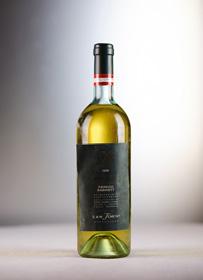

1971 BLAUFRÄNKISCH “ STEINZEILER ” , RÖMERHOF / GR OSSHÖFLEIN
My oldest red wine from Austria – and this is top-class. Purist and fragile, very slight hints of prunes, dried raspberries. Despite the fine secondary aromas of smoke and tobacco, seductive rose blossoms. The tannins very slight, dancing, paired with an animating freshness. Open and drink fast (given the quality, this should not be too hard)!
1990 MORILLON “ ZIEREGG ” KABINETT, TEMENT / BER GHAUSEN
One of the very best years for wine in Austria. Playful floral echoes, with slight exotic traces of litchi and passion fruit. Stays on the palate, playing with exotic notes, lime zest, and traces of saltiness.
1977 GRÜNER VELTLINER
“ WIEDEN ” SP ÄTLESE, SALOMON / S TEIN A.D. DONAU
Incredibly expressive bouquet, potent and concentrated. Ripe quinces, pears which appear mustier, much brioche and wild honey. Tangible sweetness, which in maturity has an exsiccating effect, with much spiciness. Gentle tea aromas bring additional complexity and tension.
98 S MAGAZIN NOBLE DRINK
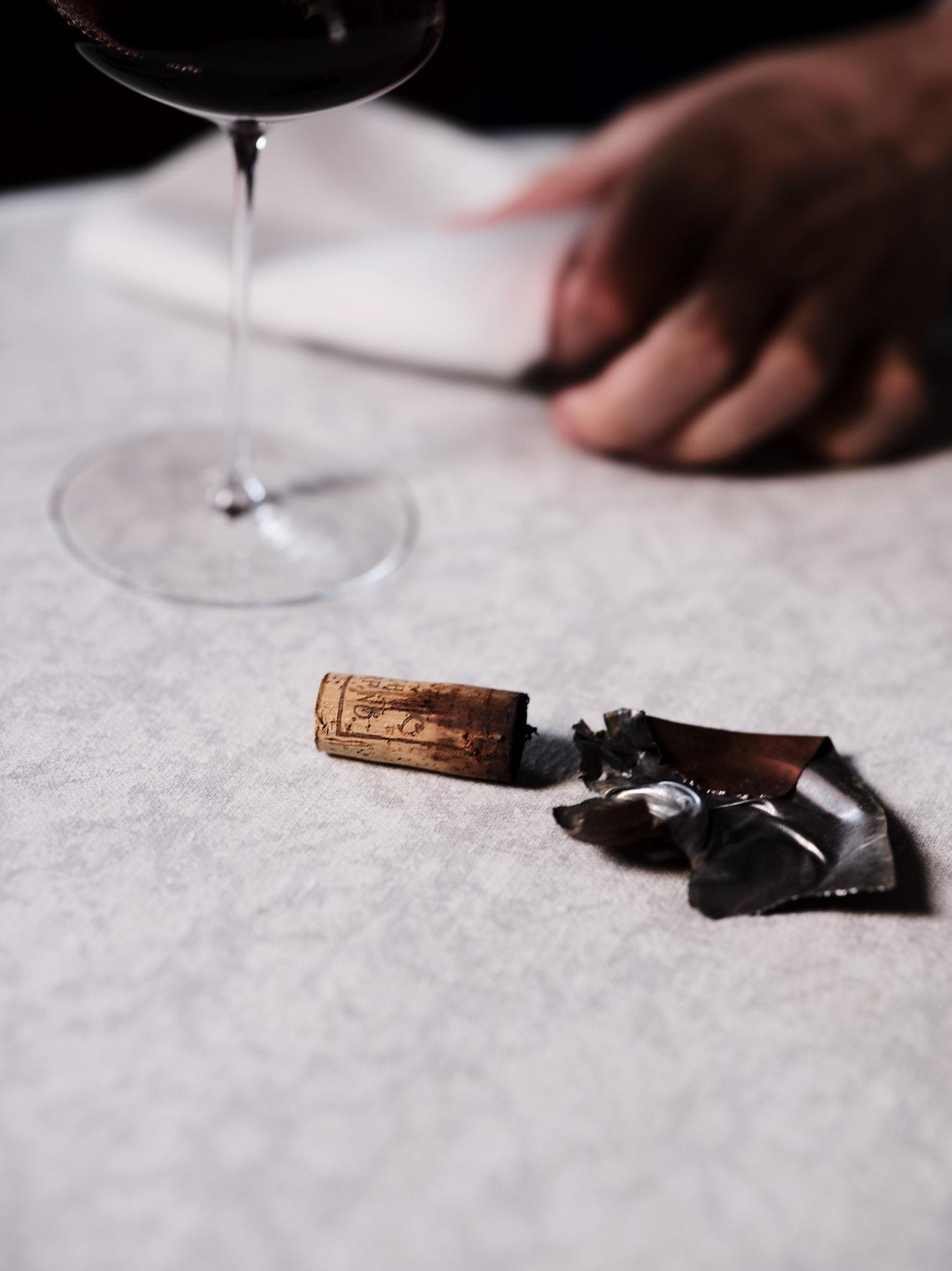
99
04 Some of the tasted wines may have passed their peak. But each has a story to tell.

100 S MAGAZIN NOBLE DRINK
05 Since 2017, René Antrag is responsible for the wine list at Steirereck. Guests now are more open to being surprised, he feels.
Reitbauer senior rang Josef Jamek and ordered wines: Ried Klaus Riesling Cabinett, Veltliner Achleiten Cabinett. One afternoon some time later, a man arrived in the old Steirereck, sat at a small side table, ate, drank two glasses of wine, and then asked for Mr Reitbauer. When he arrived, the man said, “Good day, my name is Jamek. You ordered wine from me. I will deliver.”
S MAGAZIN He would not have sold to just anybody?
SCHMID No. He went and scrutinised everything. After that, for years we had an open Jamek Veltliner from Stein am Rain, bottled for us. That was a bit of a drawback, really. Our regulars said, before I order a bottle, I’ll drink that, it is just as good. And that was of course true. If I managed to sell a bottle of wine at lunchtime in those years – late 1970s, early 1980s –, I felt like Michael Jackson. That was the stone age. And then came that awful scandal.
S MAGAZIN 1985. Wine scandal. Back to zero.
SCHMID That was the general feeling, yes. Everything was questioned. We gathered analyses and reports by the box. If ever a guest had a doubt. In Strass, the sewage plant overflowed. They allegedly locked the wine inspector overnight in a cellar, while they disposed of the wines. This would be impossible today. The guy would tweet from the cellar.
S MAGAZIN What happened then?
“And then the miracle happened: Ernst Triebaumer, Mariental 1986.”
SCHMID A miracle. Ernst Triebaumer, 1986 Blaufränkisch Mariental, received the highest honours at an international tasting. It made the news everywhere. After that, we had liftoff. People invested in quality. And then, winemakers, not just Triebaumer, were able to ask real money for their wines.
S MAGAZIN Mr Antrag, how can you learn about the wines of the 1970s and 80s? Has Mr Schmid left you enough wines from those years in the Steirereck cellar?
ANTRAG No, that would have been impossible. But we have tasted many wines together, and I was fortunate to hear many stories and to get to know many wines. Mr Schmid started early to collect wines, and I share that passion, albeit with a different focus.
S MAGAZIN Do you use mature wines in the restaurant?



2010 RIESLING “ SCHÜTT ” SMARAGD, KNOLL / UNTERL OIBEN
Wonderful Riesling from a year perceived as weaker. Not a heavyweight. Vibrant tartness and precision, very youthful. Promises to be highly amusing. I am starting to have fun.
2007 PARADIGMA (ZW, BF, M), CLAUS PREISINGER / G OLS
A cuvée, Claus’s breakthrough wine in the 2000s. Strong, spicy, juicy tannin. Good length, based on much extract. Slight echoes of leather, tobacco, and black tea make it a very exciting wine.
2005 SCHRAMMLER
“ GR ANDE RESERVE ” (GV, CH, GB), FRITZ WIENINGER / S TAMMERSDORF
The first composition of Adolf Schmid, Fritz Wieninger, and Andreas Großbauer. The grapes are from Rieden Nussberg and Kaasgraben. A lot of strength, and echoes of tobacco and white pepper. Not exactly light, but with a lot of charm and length.
101
ANTRAG Hardly. Most of the Austrian guests prefer to drink light, fresh white wines, and strong, opulent red wine. In recent years, there is a trend towards white and reds becoming more balanced. Whites become more wine-y, substancial, reds more elegant. More and more guests have come to appreciate that – they discover it through the wine / drinks accompaniment in the restaurant. 60 to 70 per cent of our guests ask for our advice. That is a high rate.
SCHMID It is a very high rate. As sommelier, you might have to struggle a little, time-wise.
ANTRAG There is a prejudice against advice over drinks and wines; claiming that it is a moneymaking scheme or a way of getting rid of unpopular or overly mature wines. But the opposite is true. We spend a lot of time thinking about harmonious choices, to ensure the evening is perfect. This means more effort, more time spent on preparation, on each guest.
SCHMID Don’t forget the many glasses.
ANTRAG In truth, you need extra staff for this.
SCHMID The restaurant is full, jam-packed, and you have to watch from the word go: When does the first course arrive at Table Seven, what is happening at Table Three, what is going on with the à la carte order for Table Five? You run around like the proverbial headless chicken. And if someone wants to talk to you – it’s curtains. I had an easier time of it. People used to order more bottles.
ANTRAG That is probably one of the major developments of the last years. People drink by the glass, they are more curious, and they like to try out new things, be surprised.
“White wine is becoming more vinous, substantial, red wine more elegant.”
Last bottle, terra incognita: 1988 Sauvignon Blanc from the Schneckenkogler winery, Ingenieur Prünte, Südsteiermark.
SCHMID This winery does not exist anymore. Prünte’s daughter married Walter Polz.
ANTRAG Yikes! This is even louder, fresher than the 1990 we had before.
SCHMID Crazy. Outrageous. It is smoky. Unbelievable.
ANTRAG Wow!
SCHMID I have a few bottles of this in my cellar. I look forward to drinking them. I do hope I will grow old.
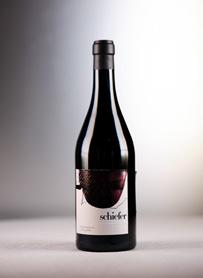

2012 BLAUFRÄNKISCH “ REIHBURG ”, UWE SCHIEFER / WEL GERSDORF
This is now essential to Southern Burgenland. What would Southern Burgenland be without this one? Substance, concentration, yet utterly drinkable. Mature, gripping tannin as basis of this meaty and tangy red.
1997 BLAUFRÄNKISCH “ MARIENTAL ” , ERNST TRIEBAUMER / R UST
Youthful, very clear and present; in its early stages. The ripe, dark berries dominate, accompanied by the aromas of dried meat, smoke, leathter, and gentle balsamic spiciness.
102 S MAGAZIN NOBLE DRINK
It was Arthur Schnitzler, who knew, “In the end, the only value lies in what we have done in life and not what we have longed for.” If that isn’t an ode to indulgence, sweet living, an exhortation to understand Dolce Vita not as a distant hope, but as an imperative of how to live, here and now. The days are becoming shorter, the sun has turned into a diva who only ever appears when she feels like it. Still, autumn shows itself in many colours, as if to say, there is magic everywhere, you just have to open your eyes. And smile sweetly, when temptation winks at you. In the shape of chocolate for instance. Whose lustre assures us: No more longing. Simply letting it melt in your mouth. Now.
Which ones & how many
S. 104
SEDUCTION S MAGAZIN SENSUOUS & S UBTLE
SWEET
3
103
SWEET SEDUCTION

IT IS LIKE A FAIRY, WHO AS A GENTLE MAGIC BEING ENSURES WITHOUT FAIL THAT WE BEGIN TO SMILE, AND TO DREAM – OF THE MANY FACES OF CHOCOLATE
PHOTOS: PHILIPP HORAK
DESSERT DREAM S MAGAZIN 104
COCOA COCONUT WATER SORBET
10 PORTIONS

INGREDIENTS
- 2 young coconuts
- 600 ml Coconut water
- 80 g Crystal sugar
- 95 g Cocoa powder
- 80 g Dark chocolate
- 1 pinch of Carpathian salt
PREPARATION
Open the young coconuts, drain the coconut water through a hair sieve.
Warm only about 100 ml of the coconut water to dissolve sugar, salt, cocoa and the chocolate. Once the chocolate-cocoa-liquid has reached room temperature, add the remaining coconut water. Stir.
Freeze the cold mass in the ice machine.
105
DAMSON CHOCOLATE SAUCE
4 PORTIONS

INGREDIENTS
- 75 g Cane sugar, brown
- 75 g Crystal sugar
- 4 g Pectin NH
- 1 Vanilla pod
- 60 g Port wine, red
- 45 g Red wine
- 80 g Orange juice
- 10 g Damson schnapps
- 4 g Carpathian salt
- 2 g Citric acid
- 400 g Damson cubes, (Steirereck TK)
- 120 g Dark chocolate
PREPARATION
Caramelise half of both sugars with the vanilla pod. Mix the rest with the pectin and put aside until needed. Deglaze the caramel with red wine and port, boil down, and add the sugar-pectin mixture.
Add the orange juice and the remaining ingredients, boil down slightly. Remove the vanilla pod and mix well.
Goes
Add the chocolate, dissolve it; finally pass the puréed sauce through a hair sieve. Serve warm.
TIPP
well with poppyseed cake, sweet casseroles, and yeast pastries.
S MAGAZIN 106 DESSERT DREAM
DRINKING CHOCOLATE (ICED)
10 PORTIONS
INGREDIENTS PREPARATION
- 84 g Crystal Sugar
- 42 g Water
- 4 Organic egg yolks (large)
- 6 g Crystal sugar
- 1½ Vanilla pods (seeds)
- 150 g Dark chocolate (melted)
- 11⁄2 Organic oranges (zest)
- 4 g Ginger (freshly ground)
- 150 g Cream
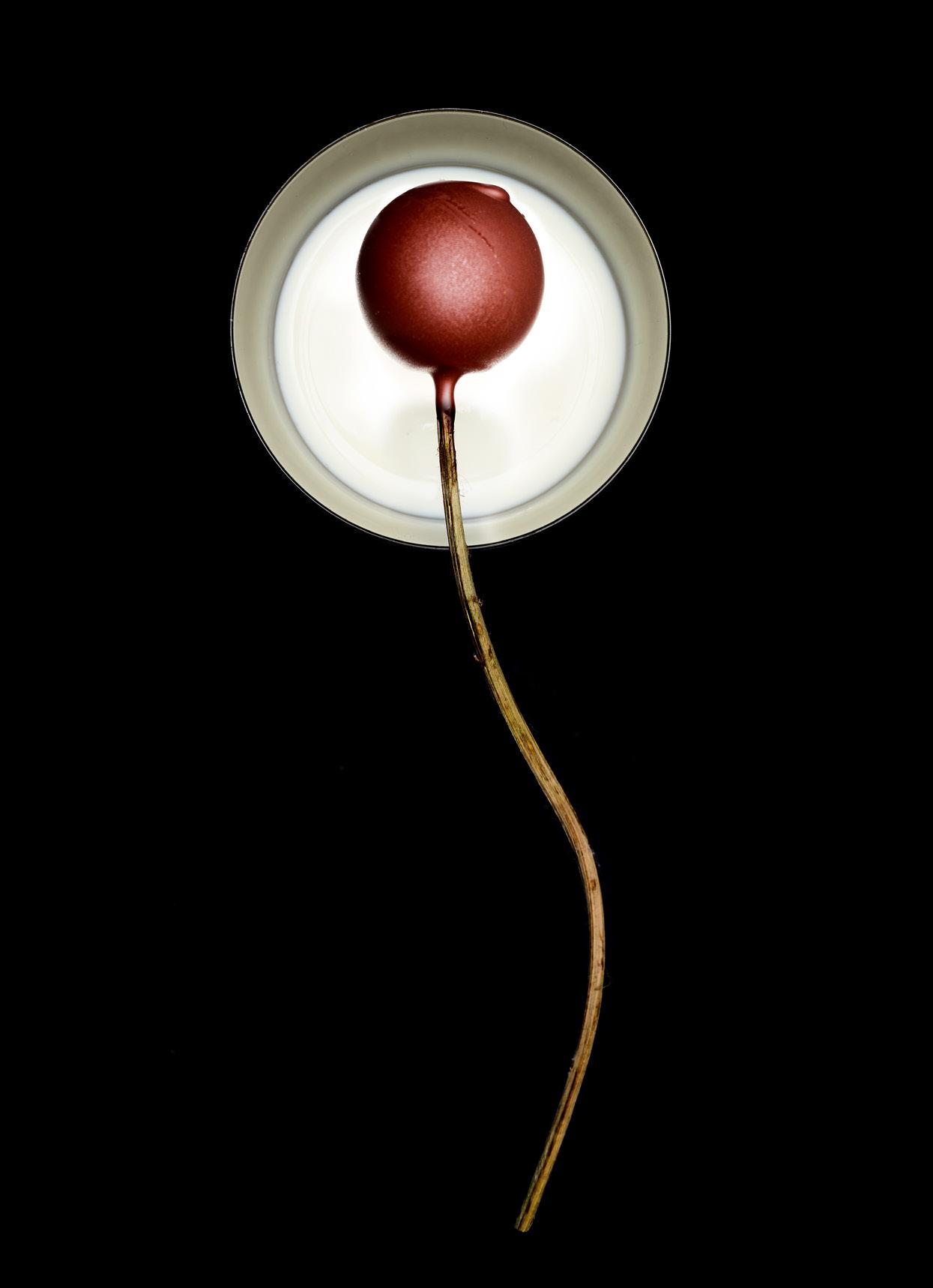
Cook everything gently for about five minutes (107 °C). Take off the heat and leave for five minutes to cool down to 80 °C.
Whisk the yolks, the sugar, and the vanilla seeds until frothy. Slowly add the cooked sugar. Whisk until cold.
Add a quarter of the egg mass to the melted chocolate, mix well. Add the orange zest and the ground ginger; afterwards, mix carefully under the remaining yolk mass.
Whisk the cream until half still and gently mix in with the chocolate mass. Fill into individual forms, cover, and freeze.
Glaze:
- 40 % Cocoa butter
- 60 % Dark chocolate
TIP
The mass must be cold before you add the cream.
Mix cocoa butter and chocolate, melt, and cool down to body temperature.
Dunk the frozen and previously skewered chocolate portions. Freeze again immediately and store covered until needed.
107
CHOCOLATE SALTED CARAMEL TART
FOR 4 SMALL TART PANS
INGREDIENTS

- 300 g Flour (smooth)
- 75 g Powdered sugar
- 3,5 g Carpathian salt
- 1 Organic egg (large)
- 190 g Butter (cold)
- 2 pieces Organic egg yolk (large)
- 135 g Crystal sugar
- 90 g Water
- 125 g Organic cream
- 219 g Butter
- 1 table spoon Carpathian salt
- 250 g Organic milk
- 250 g Organic cream
- 105 g Organic yolk
- 75 g Brown sugar
- 250 g Dark chocolate
- 1 leaf gelatine (soaked)
- Shortpastry/tart
- Salted caramel
- Chocolate tarte filling
PREPARATION
Shortpastry / tart: Mix in a large bowl.
Add the diced the butter. Pulse with a dough hook until the mixture resembles breadcrumbs.
Add and mix in quickly. Immediately afterwards, knead the mixture with your hands into a flat block, wrap in clingfilm, and chill for around 30 minutes.
Salted caramel:
Cook in a deep saucepan until the mixture turns to dark caramel.
Add on full heat and cook until smooth and viscid.
Add the butter and again, cook until the liquid has been absorbed to leave a viscous, pasty mixture.
Chocolate tarte filling:
Blend all ingredients together for 18 minutes in a Thermomix set to 10, at 70 °C.
Dissolve in the yolk mixture, while it is still warm.
Prepare Chocolate salted caramel tart: Roll out the pastry until it is about 3 mm thin.
Cut 14 cm circles and use them to line previously buttered, 9,5 cm tart pans.
Flatten the dough into the pan and trim the edges with a spatula. Cover the dough with baking parchment and fill with pebbles, baking beans or something similar.
Bake the tarts at 180 °C with air circulation for about 13 minutes, until they are golden.
Remove the pebbles and the parchment, and bake for a few minutes further if necessary.
Pour the salted caramel onto the pastry and chill briefly to allow the caramel to solidify.
Spread the chocolate filling evenly on the salted caramel tarts and chill for at least three hours.
S MAGAZIN 108 DESSERT DREAM
It was Seneca, who knew, “Life is like a play. It does not matter how long it is, but how colourful.” Well then, let’s have the time we need to see, to smell, to taste! To discover the eye for the unusual, the special! To understand culinary art as an adventure! Then, the senses can undertake journeys, to create impressions which we guard as treasure in our memories – from small-town Mailberg to Kiev. In the end, the memories of joy and pleasure stay. Like the taste of one’s childhood, as Claudia Reiterer has experienced it in many ways.
There & back
S. 110 WEINVIERTEL ECONOMIC MIRACLE S. 128 BOOKING ELSEWHERE
S. 118 CHICKEN KIEV WAS YESTERDAY
S. 126
4 109 S MAGAZIN NEAR & F AR
THE ANIMAL TAMER BETWEEN RICE WITH PEAS AND CARPACCIO
Weinviertel ECONOMIC MIRACLE
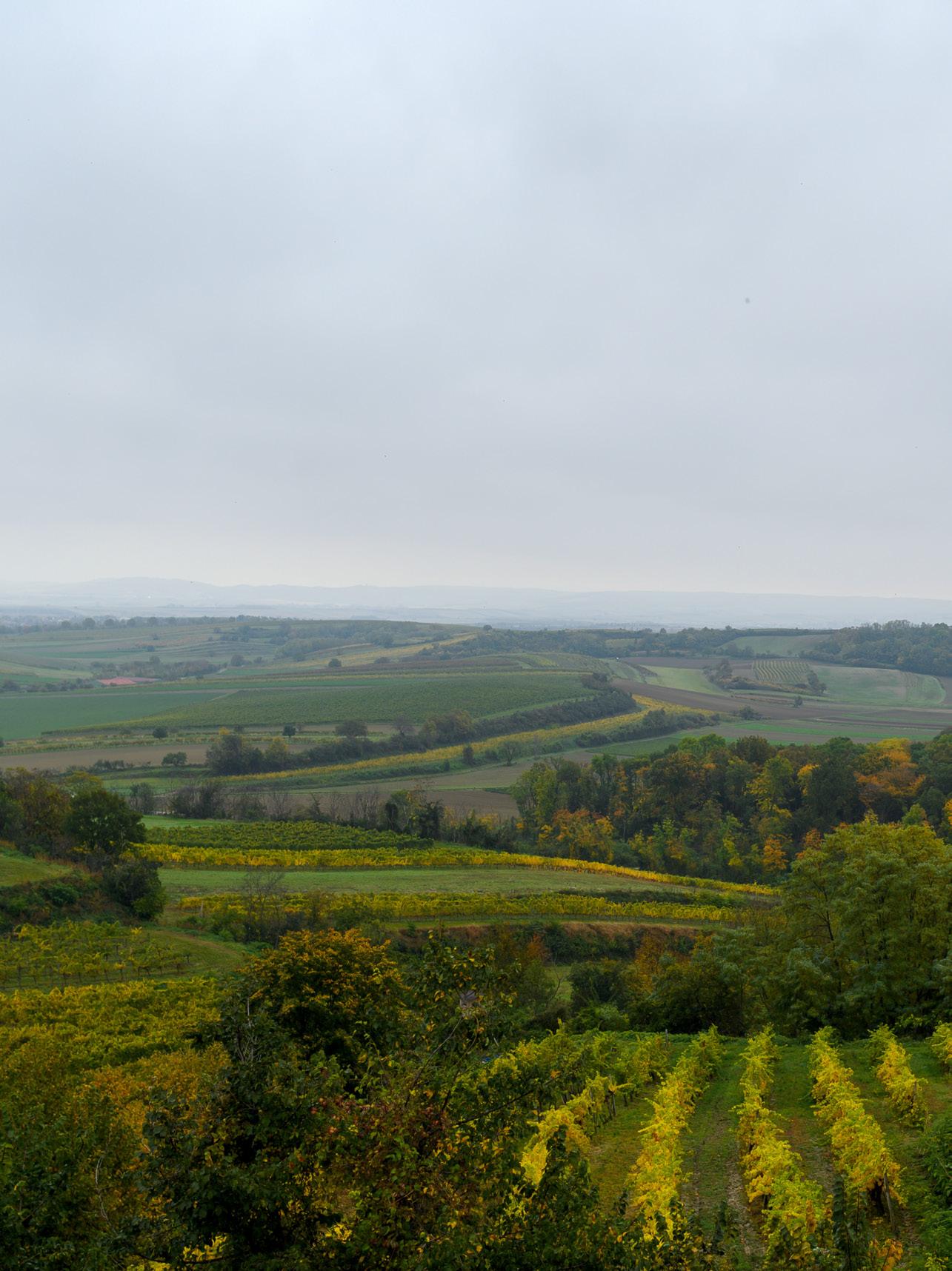 TEXT: ACHIM SCHNEYDER, PHOTOS: MIRCO TALIERCIO
TEXT: ACHIM SCHNEYDER, PHOTOS: MIRCO TALIERCIO
110 S MAGAZIN HOME VISIT
This is the story of two young people, Verena und Christoph, who wanted to build something together. Which they managed. Birgit and Heinz Reitbauer can attest to it.


01-02 Two, who found each other, first privately, then professionally: Verena Schneider and Christoph Schüller.
Do you know Mailberg? No? Not to worry. Although: maybe you should, you should certainly know Genusswirtschaft. Which is in Mailberg. And why should you know Genusswirtschaft? Because it is a most excellent restaurant.
In truth, the story of Genusswirtschaft is a bit of a love story. Which deserves to be told. And Steirereck plays a role. As does its retired sommelier, the legendary Adi Schmid. And Birgit Reitbauer, the Steirereck landlady, is more than an innocent bystander in this story. But first some information on Mailberg itself. Here goes: Mailberg lies in the northern part of Weinviertel (“Wine District”), near the town of Hollabrunn in Lower Austria. Mailberg boasts a castle, which will play a role in this story, and a few wine-growers, some of whom are not unknown. The best-known among them is Wolfgang Hagn. A good man. And the Mailberg Kellergasse, the local row of wine cellars, Kellergasse Zipf, con -
sists of a lower and an upper row, which is listed as a historic monument. By the way, there are almost 200 wine cellars in Mailberg. Rather a lot, given that there are only 557 inhabitants, according to the official figures of 1 January 2019.
Speaking of dates, on 4 July 2006, two dates after her return from her Maturareise, a journey young Austrians undertake after passing their final exams, a certain Verena Schneider started working at Steirereck. She was 19 at the time, having graduated from HLW Mistelbach, a special high school for economic professions. At first, she assisted in the restaurant’s service. Today, the young woman recalls, “Before the journey, I sent out two job applications, one of them to Steirereck. I didn’t think I would get a reply. But Birgit Reitbauer answered by return of post, and invited me for a talk. Even before I went on the trip. And just like that I had a job, although I never would have thought it would be that fast.”
111
Well, sometimes things move fast. Also in love. Because two years prior, 17-year-old Verena was in the Tyrol, completing her mandatory internship, she met a chef, seven years her senior, and they kind of fell into each others arms. His name was Christoph; it still is, Christoph Schüller. And today, these two are – you guessed correctly – landlady and landlord of Genusswirtschaft, in the nowhere of Lower Austria, beg your pardon: in Mailberg.
Leap forward in time. The date is 20 October 2019. Lunch at Genusswirtschaft is over, and Verena nervously takes a pull on her cigarette. “The boss doesn’t know I smoke,” she says; at any moment, the boss could come around the corner and catch her at it. The boss? “Yes, I still call her that. Strange, because I left Steirereck in 2012. But this wonderful woman will always be an authority figure for me; I have learned so much from her. Steirereck was my life.”
Verena’s telephone rings. It is Birgit. “We will be there in half an hour,” says the boss, “and when we arrive, I will immediately need a glass of ice-cold champagne. I deserve it today.” She was on duty, was Birgit, unexpected Sunday duty at Meierei, filling in for a sick member of staff. “She will get the champagne,” says Verena.

So we still have a bit of time before Birgit and Heinz Reitbauer will have found their way to Mailberg. “They are coming for the first time”, says Verena and refills our glasses. White wine from Weinviertel. “May I have a look at your wine list?”, I ask. “Naturally”, says Verena. “But you won’t know all the wine-makers, 90 per cent are locals from Weinviertel, and some are relatively unknown.”
A wedding is not on the menu for the time being. The innkeepers have not had the best of experiences with weddings…
 03-04
03-04
112 S MAGAZIN HOME VISIT
The tables in the restaurant are elegantly laid. Although in truth, this restaurant is a small dining room with four tables, adjacent to the bistro with its open-plan kitchen.

113
05 Verena Schneider, the lady of the house, loves her life as forthcoming, charming hostess. Birgit Reitbauer was her teacher at Steirereck for many years, and Verena learned a lot from her, “I am, like her, an alpha dog.”
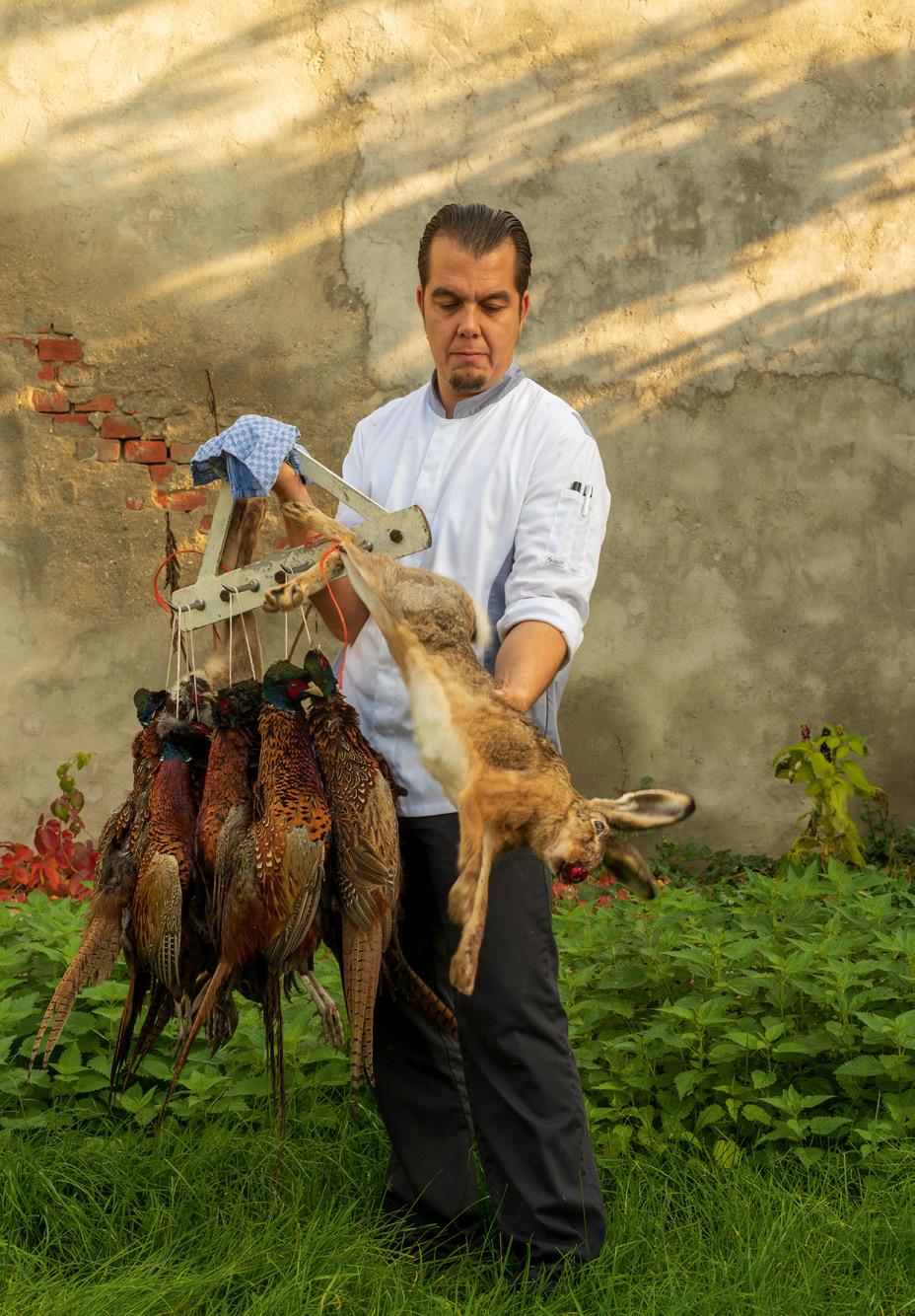
114 S MAGAZIN HOME VISIT
06 Good things from close by. Christoph Schüller obtains as many things as possible from their immediate surroundings, like pheasant or rabbit. He makes an exception for sea fish, as they are not exactly native to Mailberg. “From time to time, people want sea bass.”


So, at Genusswirtschaft too, regionalism is the magic word. It is often overused; but here, it feels real, honest, and right. Just today, on this 20 October, a local hunter and a friend, brought the chef, that is the landlord, which is to say Christoph, brought him 35 freshly shot hares and 20 pheasants, which are now in the basement, awaiting treatment. “I set my alarm to five a.m.”, says Christoph, whose cold store is filled with delicacies which can be bought at Genusswirtschaft to take home. Home-made ketchup, different kinds of pickled vegetables, or jams. “If our hunters bring deer, I use everything. The pelts are taken to the tanner. And I make leather cleaning cloths, which people can buy from us.” As the Reitbauers have not yet arrived, we continue to sit on the terrace, smoking and chatting about the past. “We always dreamt of having our own restaurant”, says Verena. And Verena and Christoph tell the story of the castle’s cellar.
The restaurant in the cellar of Schloss Mailberg, which also housed – and still houses – a hotel, was up for lease. Verena, who had grown up in Michelstetten, about 25 minutes’ drive away, knew the castle. “Let’s do it”, the two lovebirds decided, but as they were young, they were somewhat hesitant, unsure. This was their plan: Lease the castle’s cellar, and leave Christoph to cook. Verena was to stay at Steirereck, and to commute on weekends. By now, she had become Birgit’s right hand in the service department and as hostess. Which meant she had perfect standing and a perfect job. “We felt secure”, Verena says, “but then Adi Schmid, the sommelier, talked to me. ‘Verena,’ he said to me, ‘if you want to do something together, that’s what you have to do.’ And he kept at me, until I made up my mind.”
The parting from Steirereck in 2012 was quick, but painful. “We both cried our eyes out”, Birgit recalls. She and Heinz have meanwhile arrived at Genusswirtschaft, and Birgit is enjoying her champagne.
07-08 Right behind their house, where the real Weinviertel begins, the cook follows his vegetable farmer through their fields to inspect the offerings of the day. Right: herbs in the back yard.
115
On 1 April 2012, Verena and Christoph opened Schlosskeller. Half a year later, Christoph was awarded a Gault-Millau toque. “But I lost it soon afterwards –29 weddings, two balls, and four large feasts on –, because all of a sudden, we had stopped being a restaurant, and become an event location.” They decided to call it quits, to stop saying yes to everything, and to focus on the essential, the cooking and hosting. In 2015, they were awarded two toques. “But it wasn’t our own restaurant”, muses Verena. And then the old greengrocer’s in Mailberg became available. “It had been left empty for forty years, and it was for sale. So we decided to risk it.”
In September of 2017, Verena and Christoph finally opened their very own inn, completely restored and refurbished. In addition to the restaurant, Genusswirtschaft has three guest rooms on the first floor. It may not be big, but it is harmonious. As you enter, you find yourself in what they call a bistro, with an open plan kitchen. The adjacent room is the dining room, with only three tables. The restaurant. 40 seats in total. Small, but very beautiful.
Reitbauers are seated, the table has been laid in the restaurant, Christoph has prepared a nine course surprise menu. Among other dishes, he serves
venison, beetroot, Danube salmon, pigeon or gilthead seabream. It tastes good. It tastes truly wonderful. And Verena is a perfect hostess. As if she learned from Birgit. Which she did. “One day”, says Verena, “the boss told me that we might collide every now and then, because we are both alpha dogs. And of course it happened, but I wouldn’t want to miss any of our arguments, because each of them taught me something.”
Taught her a lot, one is tempted to say as guest, as Verena is a textbook hostess. And her beloved, Christoph Schüller, is a true masterchef. Only one question remains: Why haven’t the two tied the knot yet? “He hasn’t asked me”, says Verena. And laughs. “Weddings”, he says, referring to Schlosskeller, “haven’t exactly brought us luck.” And he too laughs.
Adi Schmid, the legendary sommelier, talked them into independence.
 09 At the table. Birgit and Heinz, Verena and Christoph. The latter has created an eight-course surprise menu in honour of the Reitbauers’ first visit.
09 At the table. Birgit and Heinz, Verena and Christoph. The latter has created an eight-course surprise menu in honour of the Reitbauers’ first visit.
116 S MAGAZIN HOME VISIT


117
10-11 The kitchen, where Christoph works, is open-plan; you can watch “live” from the Bistro, as delicacies like beetroot are artfully arranged on the plate.

CHICKEN KIEV WAS YESTERDAY
PHOTOS: MARIA PAVLIUK
118 S MAGAZIN TRAVELS OF TASTE
DESPITE THE POLITICAL UPHEAVAL, THE UKRAINIAN CAPITAL KIEV HAS BECOME ONE OF THE MOST POPULAR DESTINATIONS IN EASTERN EUROPE, LARGELY THANKS TO THE EXCELLENT FOOD. SEVERIN CORTI WENT TO SAMPLE THE CITY’S AUTHENTIC TASTES – AND MANAGED TO AVOID THE INFAMOUS CHICKEN BREAST WITH ITS MELTED BUTTER CORE.
Are you kidding? A gourmet tour through Kiev, without the eponymous dish, which made the city’s name known around the world? Especially since practically every restaurant lining Chreshatyk, the city’s grand six lane boulevard, advertises the speciality loudly from afar, in creative variations: “Kiewsker Heunerchen” is meant to be German.
One problem with this is that the “Côtelette de volaille à la Kiev” is not originally from here, but was invented in an aristocratic club in Sankt Petersburg at the time of the tsars, very likely by a French chef. The other, that it seems pointless to fill the sapless breast of a battery hen with a torpedo of fat, then bake it in industrial grade oil, in order to douse the unsuspecting guest and his clothes with a stream of liquid butter, usually only flavoured with garlic granules.
No, no, no! At a time, when the chicken breast had to come from a perfectly hung, wild hazel grouse, and the butter filling was laced with quite a bit of truffle, such a chicken à la Kiev would have been worth sinning. But nowadays, Kiev has much more exciting fare on offer. The city oscillates between a charming and slightly fading turn-of-the-century flair with gorgeous cobbled avenues, and a glittering modernity, whose ostentatious style avers the extrovert nature of the local oligarchs and their deep wallets. The freshly gilded onion domes of the orthodox cathedrals and the grand sweep of the Dnjepr, on whose banks the city was erected, give an almost exotic impression.
119
RESTAURANT KHUTOROK
The Restaurant Hutorok appears rather exotic as well; it is a wooden ship, moored on the banks of the river. The boat looks exactly like you have learned to imagine Noah’s Ark. The interior seems preoccupied with saving threatened local traditions. But do not be deceived by the folkloristic furnishings: This place celebrates authentic Ukrainian cuisine at the highest level.
You get a sense of this right away, as you enter, you are greeted by a massive charcoal barbecue. On it, several kinds of shashlik, and well-seasoned juicy skewers of lamb and pork. It becomes clear as the zakuski arrive, cold starters accompanied by an entire battery of home-made infused herbal and spicy vodkas. The salted pickled herring is world class, and the seven different variations of “salo”, the typical, smoked, marinated, and dried fatback, serve as a perfect basis. Combined with fermented vegetables, from freshly pickled gherkins to all kinds of roots and to tomatoes, which slightly prick your tongue, these are first bites, which might actually curb your hunger for what is to follow – not everybody is blessed with a Slavic appetite. If you come in summer, you must not forgo the incredibly refreshing akroshka, a soup of buttermilk, cucumbers, and aromatic herbs, served in a bowl of thick ice.


120 S MAGAZIN TRAVELS OF TASTE
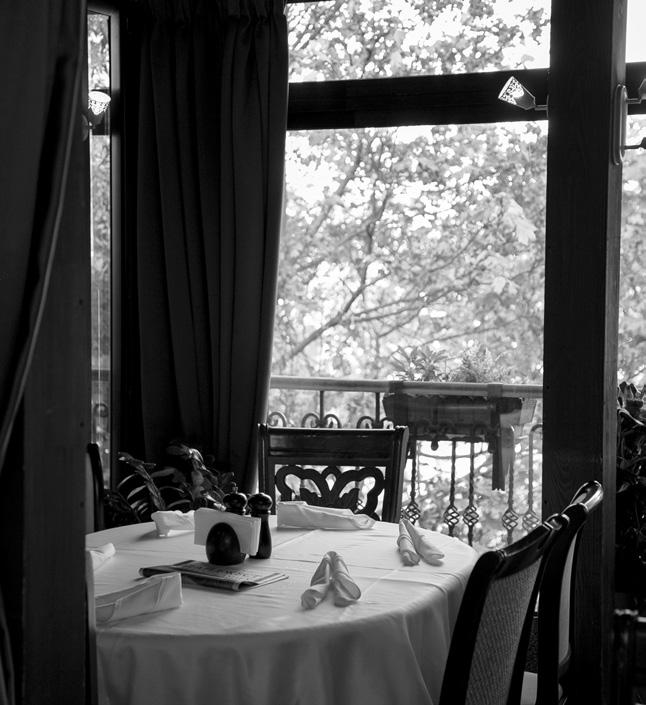

RESTAURANT KANAPA
Ukrainian dishes from the presoviet era are the speciality of the restaurant Kanapa, which has recently opened in a listed wooden building in the old city centre. Borscht, garnished with pork ears, as it should be, is inevitable in this place. Varenyky, a crescent-shaped kind of ravioli, wonderfully firm to the bite, are filled with zander and smoked salo – the art of filling pasta is not an Italian prerogative. The aspic made of pheasant and hare with horseradish has a rather firm texture, the potato fritter, topped with a ragout of veal brain, sweetbread, and wild mushrooms is a deliciously savoury combination of creamy crispness and mysterious flavours.
BAKERY KHLEBNIY
Khlebniy, the newly opened designer bakery, exhibits echoes of Stalinism, or rather Stalinist art and architecture. It is located in a monumental Stalinist building, and the interior is dominated by a largerthan-life-size mural of a Ukrainian farmer’s wife. The baguettes are sensational. And we would love to have their buttery donuts in Vienna!
121
ZIGZAG-CAFÉ
The city’s European heritage is obvious in TV journalist Lyubov Tsybulskaya’s Zigzag Café. It is the delightful hangout of Kiev’s art and media scene: the drinks are mixed with great care, the jazz playlist is carefully curated, very well put together. The café offers a menu of small, seasonal delicacies designed to show off the culinary richness of the region. You simply have to try the hand-cut tartare with forest herbs, and you should definitely not miss out on the brioche pain perdu, served with wild blueberries and strawberries.

MARKET HALL ZHYTNIY
At Zhytniy Covered Market, you can see for yourself that such wild delicacies are easy to come by in Kiev. Local farmers offer terrific vegetables, apparently organically grown from actual heirloom seeds. The stalls of smoked fish and countless varieties of caviar attest to the – hopefully undiminished – abundance of species in the country’s rivers, lakes, and coastal waters. Pickled gherkins in all stages are a welcome remedy after long vodka nights. The baskets of wild strawberries, blueberries, raspberries and blackberries appear to have come straight out of a fairy tale; not to mention the incredible variety of wild mushrooms on offer, all of pristine quality.
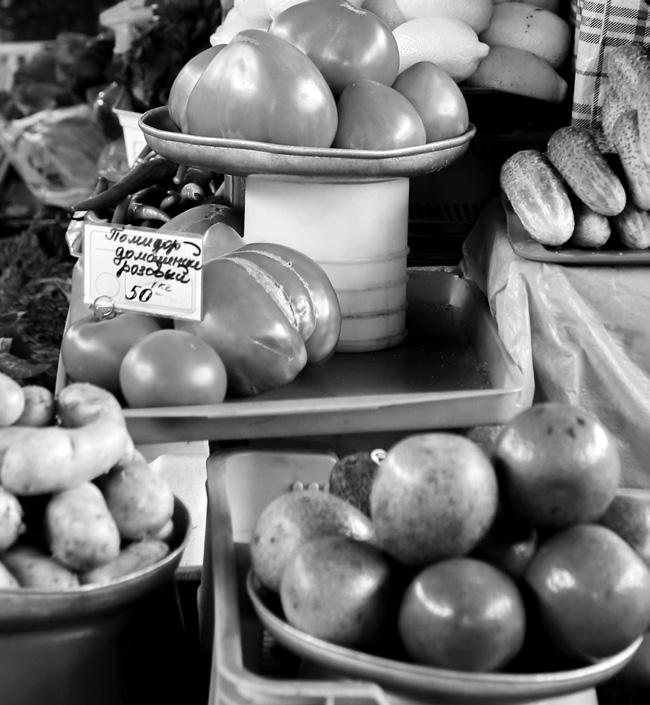
122 S MAGAZIN TRAVELS OF TASTE

123
WIN BAR
Kiev has also a very different side, utterly swank and refined. A visit to the Win Bar, established with some effort and at great cost in an antique pharmacy, brings you in touch with the young, the beautiful, and the rich of the city. All kinds of Mediterraneaninspired (and really well-made!) food is served, with mostly French wines and sparkling wines.
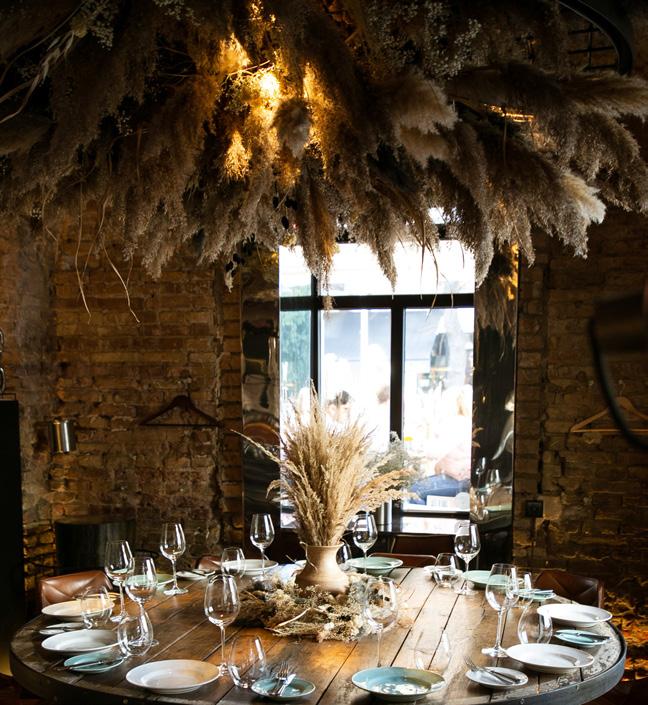
RESTAURANT SHOTI
A restaurant like Shoti on the other hand would be an asset for a sophisticated metropolis like London or New York. Shoti offers Georgian cuisine of the highest level. The best of Georgian amphora wines are served in a classy, subdued atmosphere. A mighty open fireplace with a crackling fire dominates what is arguably Kiev’s most fascinating restaurant. Traditional Georgian bread is baked in a massive clay oven. The wonderfully juicy Khinkali dumplings are proper works of art, filled with meat and an incredibly flavourful soup; the classic Khatchapuri cheese pies are of a hearty elegance (they come in six different styles!), and the salads with their abundance of fresh herbs are a delight. Many ingredients are delivered specially from Georgia.

124 S MAGAZIN TRAVELS OF TASTE


LOGGERHEAD
And afterwards? You queue, with a group of highly attractive young people in a dark backyard of a dilapidated building beside a rusty iron door to be eventually let into the Loggerhead. Inside, the classic speakeasy proves to be a dimly lit, exclusive cocktail bar. The signature loggerhead turns out to be a metal plunger, which is heated up with a special tool and then dunked into certain drinks to caramelise the sugar in them, with a loud hiss and to maximum effect.
HOTEL BURSA / B AR 1818
For warm nights, we recommend Bar 1818 on the roof of the Bursa boutique hotel. The hotel has a personal style all its own; it is decorated with contemporary art. The bar is tiny, but the terrace with its view of the old city is spectacular. But careful: The bartenders are ultra hip, and justly proud of their professional ethos. You must order one of their Avantgarde cocktails. If you simply want to hold on to a beer, you will be given a certain look.
125
CLAUDIA REITERER’S
REMINISCENCES OF TASTE,
WRITTEN DOWN BY MICHAEL HUFNAGL
THE ANIMAL TAMER BETWEEN RICE WITH PEAS AND CARPACCIO
PHOTO: PHILIPP HORAK
As a child, she dreamt of a small witches’ cabin in the forest. A tiny, cosy refuge, where she could live by herself. On nature’s culinary gifts. A fantastic, colourful idea, and a far cry from the loud media circus which is Claudia Reiterer’s life today.
Every Sunday, the 51-year-old Styrian has to play the role of animal tamer in the political panel discussion “Im Zentrum” (In Focus) to keep the tempers of the different personalities, political wildlife, in check. As the blonde hermit in her kingdom between birdsong and the clip clop of hooves she would only have had to think about stocking enough berries and herbs.
But the idyllic imaginations of a little girl growing up in the hamlet of Fersten in Eastern Styria (part of Sankt Johann in der Haide), with but 17 houses, 56 inhabitants, one single sign with the village’s name on it, and one single sentence, “You have to eat beetroot to get red cheeks”, usually only reflect what she already has.
Or has not. Claudia Reiterer comes from a simple background. “You eat what is on your plate. Every little morsel.” So she had rather humble plans for her life. Early on, she helped the local famers pluck apples or strawberries, to earn a little money. “I preferred plucking string beans. They grow on tall stalks, which makes the job much easier.”
To be in close contact, in touch with fruit and vegetables, earthy and honest, felt natural. “We only had meat on Sundays. I remember with relish the schnitzel in its thick cream gravy.” With cake, cookies, or a swiss roll for afters. “My favourite were the spagatkrapfen. It was fascinating to watch them being made.”
Like farmer’s bread. Made from sourdough, obviously. The memory of the old iron oven puts the ORF presenter in a melancholy mood. As Steirereck’s “Brot Andi” turns the corner and starts calling out, her eyes begin to shine. “Good bread is absolutely essential to me,” she says.
This is immediately followed by a surprise. While sophisticated Reitbauer delicacies like river crayfish with tomatoes and santolina viridis, eel with lime and peanuts or wild hare with cantharellus mushrooms and barberry are being served, she enthuses over rice with peas and endive salad. “This was my favourite food as a child. I still eat it, often. To me, this is a taste connected to only good things. I also like to have the salad with krumpan, which is what we called potatoes at home.”
She feels the same ecstasy for cold sauerkraut with pumpkinseed oil, or the so-called “beggars’ soup”, a welcome greeting from the past. With krumpan and carrots – “… of course without stock cubes. My son loves this soup as well.”
By contrast, Reiterer never had any time for pumpkins, regardless of the variety. In Styria, her dislike is considered sacrilege. Or simply grotesque. But time heals all the strange looks, and so she smiles, happily, as she is served first celery and then fennel à la Steirereck, because they too, have always been on the list. “I don’t need them.”
But the subtle blend of tastes, the spices, and not least the aesthetic presentation ensure that some prejudices evaporate like kitchen steam. “Wonderful”, she says, and starts to think.
126 S MAGAZIN TABLE TALK

In suchs conditions, perhaps even brain and kidneys, innards and sweetbread might warrant a second try.
Reiterer turned away from offal long ago –“Apart from liver, which I enjoy in all kinds of variations”. Who knows? Maybe a magician-cook would be able to transport Claudia Reiterer into another dimension.
“You have to try everything, as in life,” she muses, almost philosophically. “Eating feeds the soul. And a metaphor for always trying to walk new paths. You can always turn around. But if you never stray from the well-trampled road, you will never know what you might miss.”
True to herself, after two semesters in cookery college, she moved to Graz. “For my exam, I had to prepare pancake soup, liver, and a cherry strudel. Unfortunately, the dough I made looked like a silk screen print.” In Graz, she lived in a student dorm run by nuns, where they were fed a bland diet. “The food was dreadful. But I still see before me the silver cart with the alluring pot of drippings … we snuck in for a taste.”
Later, Claudia Reiterer worked as a fully qualified nurse in cardiac surgery, before she applied for a job in television – and was hired on the spot. At the end of the 1990s, she followed the call to work for ORF in Vienna, and in the autumn of 2016, after years of hosting political programmes like “Hohes
Haus”, “Report”, and “Konkret”, she was selected to take over as presenter of the Sunday evening talk show.
An interesting fact: She was 25, before she had fish in a restaurant – for the first time in her life. “We never had fish at home. I had to discover it for myself, how delicious char, trout, or catfish can be.” And so many other things besides. With her rise to indispensable TV personality came a new consciousness. For indulgence and kitchen magic. “All of a sudden, I learned to appreciate the appeal of truffles or carpaccios, and I know now that to be able to afford good food, is a true luxury. I worked hard for that.”
But she remained grounded. And that is of great importance to Claudia Reiterer, not just in a profession which sometimes calls for an unpleasant assertiveness and willpower. To never forget where you come from and who you are became her creed.
She herself likes to cook quick and easy meals. “If my son says, I am hungry, he wants half a wild boar on the table in twenty minutes.” The passionate TV journalist does not like to spend her time in the kitchen. She prefers to enjoy here friends skills, who admit to a boundless love of cooking. “I am a much better eater than cook”, says Claudia Reiterer. She takes a sip of rosé, a bite from her blood sausage bread and smiles. One would like to say, like a princess in her small witches’ cabin.
CLAUDIA REITERER – a Styrian who dreamed of life in the forest, who has not forgotten, where she comes from, and who will not renounce her love of endive salad.
127
BOOKING ELSEWHERE
RECOMMENDATIONS BY BIRGIT UND
HEINZ REITBAUER TEIL 12
No city in world has been more in the media, no city has been more researched as the culinary place to be than Paris. Which makes it all the more amazing when time and again certain unexpected special recommendations surface. And far away Singapore is definitely worth a journey, full of insider tips. •
BURNT ENDS
Singapur
If you sit down at the bar of Singpore’s Burnt Ends, you find yourself immediately caught in the atmosphere. The busy bustle around the stove is fascinating, and the three grills make time fly. Whether vegetables, fish, or meet, extremely fresh seafood, everything is cooked or grilled in the wood stove or on the grills. With a lot of sensitivity, one delicacy after the other is served. The grillmeister and the attentive staff are always up for a joke and create a relaxed atmosphere.
NOURI
Singapur
A small restaurant, tucked into a quiet side street of Singapore. Impossible to guess from the outside what amazing foods are dished up inside. Ivan Brehm, who once worked for Heston Blumenthal, now has his own place where he serves light, elegant, cosmopolitan cuisine, in a wonderfully creative manner. The many influences and inspirations from all over the world are woven into Asian tastes; always done lightly and tastefully.
CLAMATO
Paris
The Clamato in Paris is the little sister of the famous Septime. What is truly wonderful is that you can drop by any time without a reservation; with a little bit of patience, you will get a seat, especially on Sundays – which in Paris is a bit of a gamble. Sharing is the order of the day; sharing is wanted and elevated to an art – of extremely fresh oysters, sea snails, mussels and scallops in a heavenly sauce, for which you almost invariably run out of bread for dipping, or a classic fried Dover sole. There is a well thought-out wine menu, with a fine selection, served by the glass or by the bottle.
FULGURANCES
Paris
The truly extraordinary thing about Fulgurances is that every six months, there is a new chef cooking, who is also responsible for the menu. This concept offers young (sous)chefs the opportunity to leave the relative obscurity and become a “star”. A playground which allows a chef to experiment, to try, to sound out. He or she has carte blanche and full responsibility. And they all know how to deal with that in the best possible taste. It is truly wonderful, to not have to decide anything, but only to enjoy, after the old adage, Que sera, sera.
ADRESSES
BURNT ENDS
20 Teck Lim Road, Singapur 088391 burntends.com.sg
NOURI
72 Amoy Street, Singapur 069891 nouri.com.sg
CLAMATO
80 Rue de Charonne, 75011 Paris clamato-charonne.fr
FULGURANCES
10 Rue Alexandre Dumas, 75011 Paris fulgurances.com
128 S MAGAZIN RECOMMENDED RESTAURANTS




























 HOME OF FINE WATCHMAKING SINCE 1833
HOME OF FINE WATCHMAKING SINCE 1833



































































































 EDITOR: MICHAEL HUFNAGL
EDITOR: MICHAEL HUFNAGL






























 TEXT: ACHIM SCHNEYDER, PHOTOS: MIRCO TALIERCIO
TEXT: ACHIM SCHNEYDER, PHOTOS: MIRCO TALIERCIO



 03-04
03-04




 09 At the table. Birgit and Heinz, Verena and Christoph. The latter has created an eight-course surprise menu in honour of the Reitbauers’ first visit.
09 At the table. Birgit and Heinz, Verena and Christoph. The latter has created an eight-course surprise menu in honour of the Reitbauers’ first visit.














